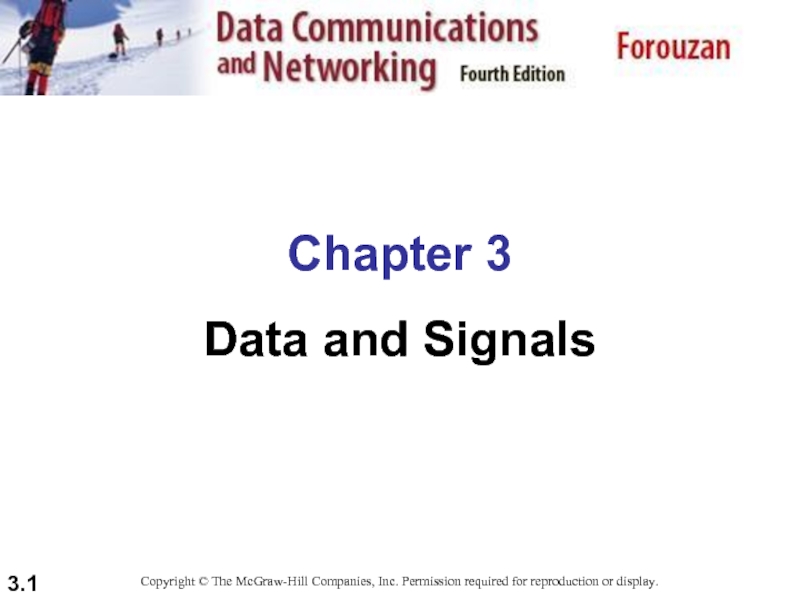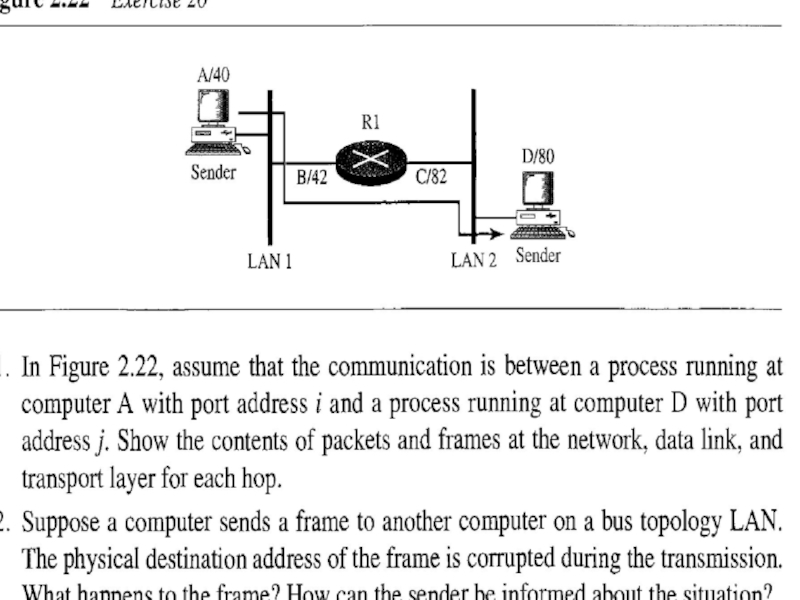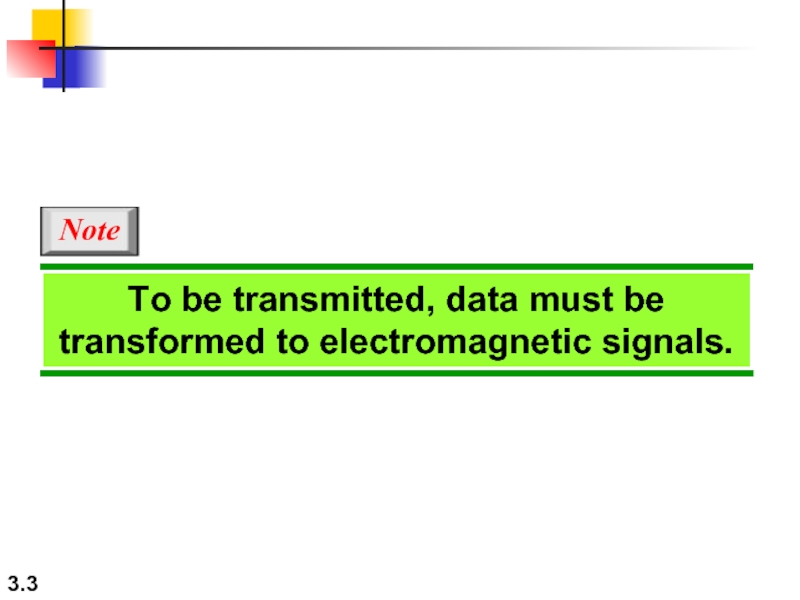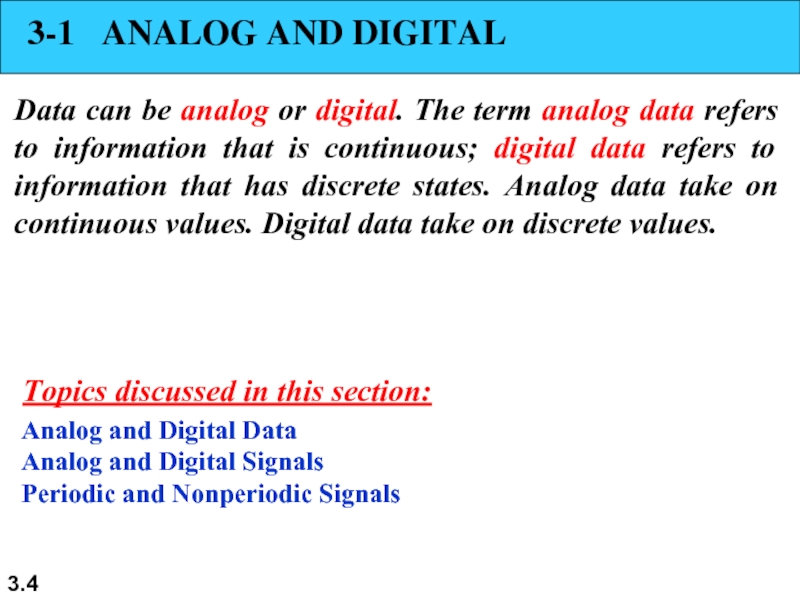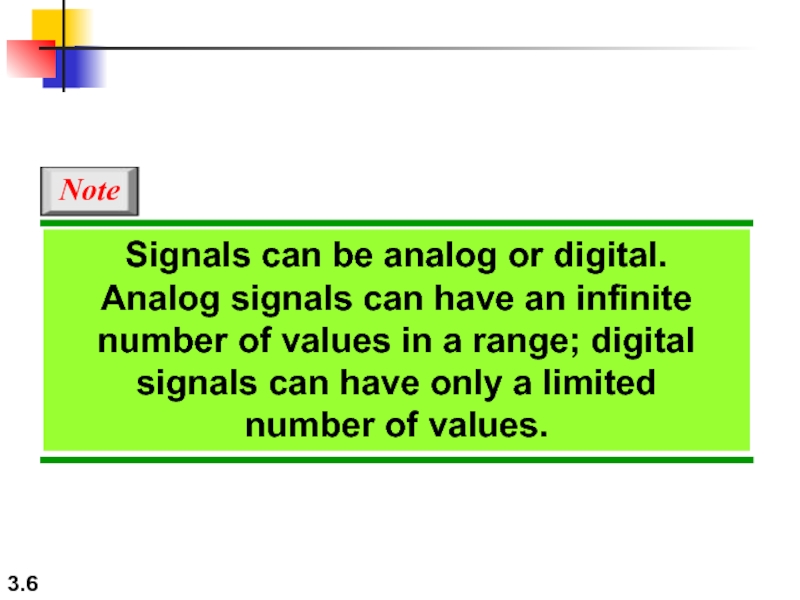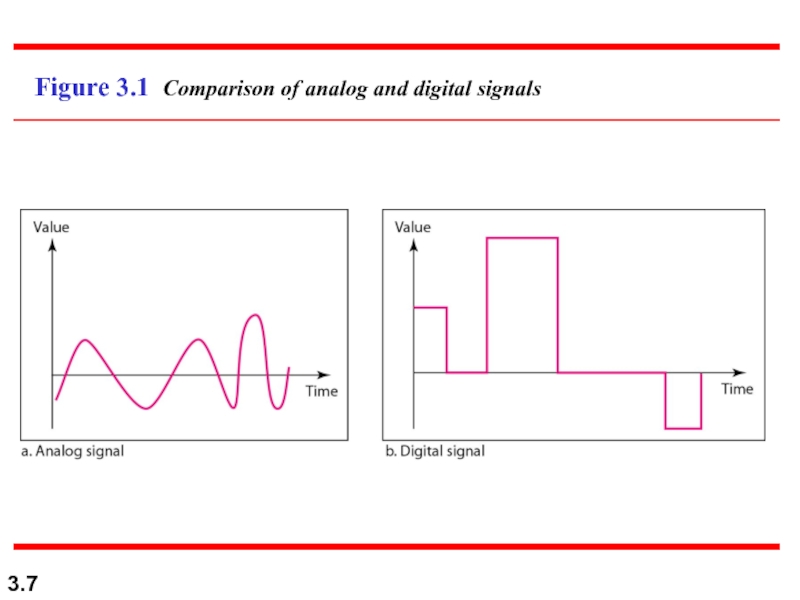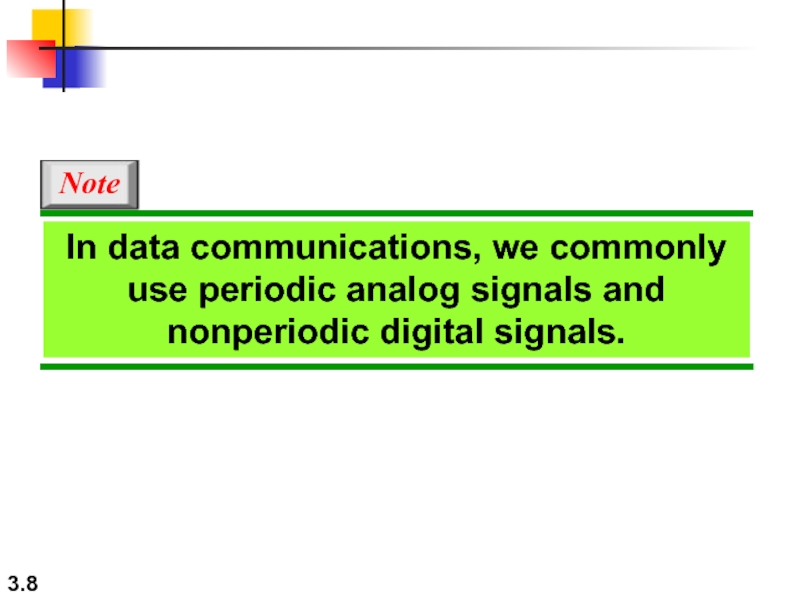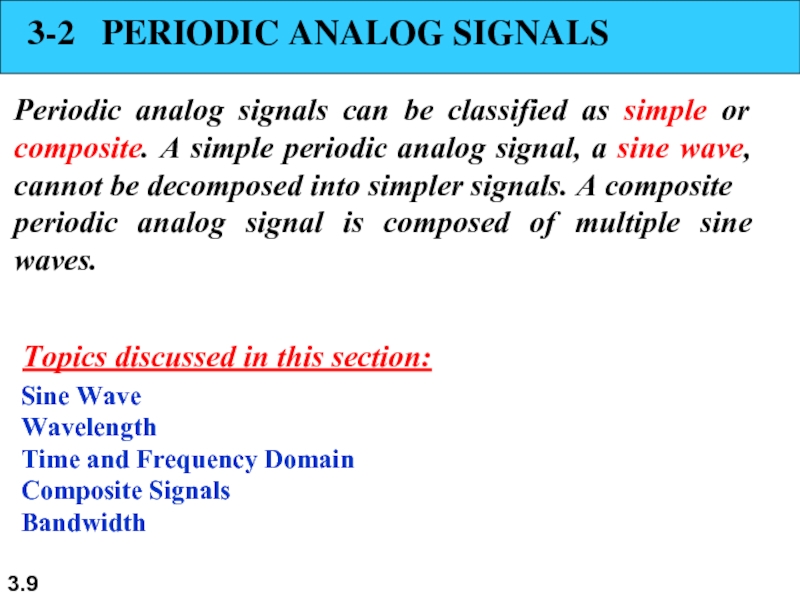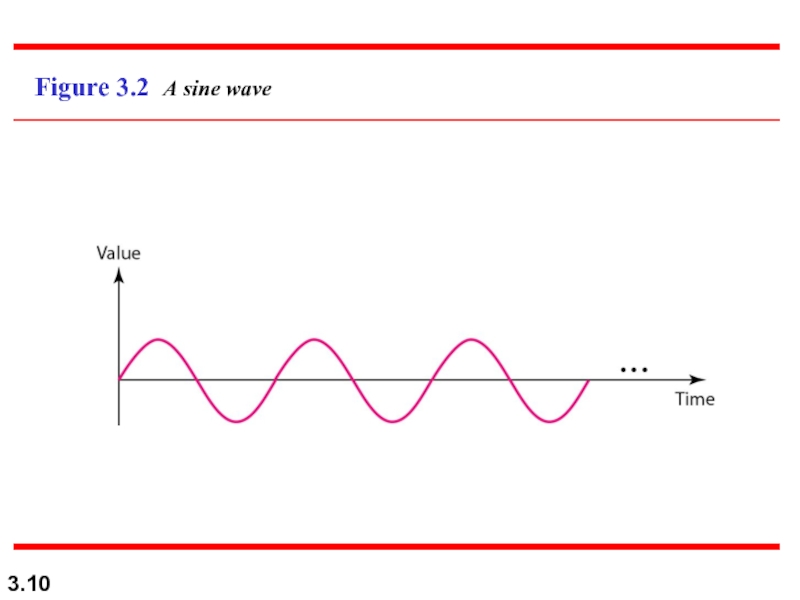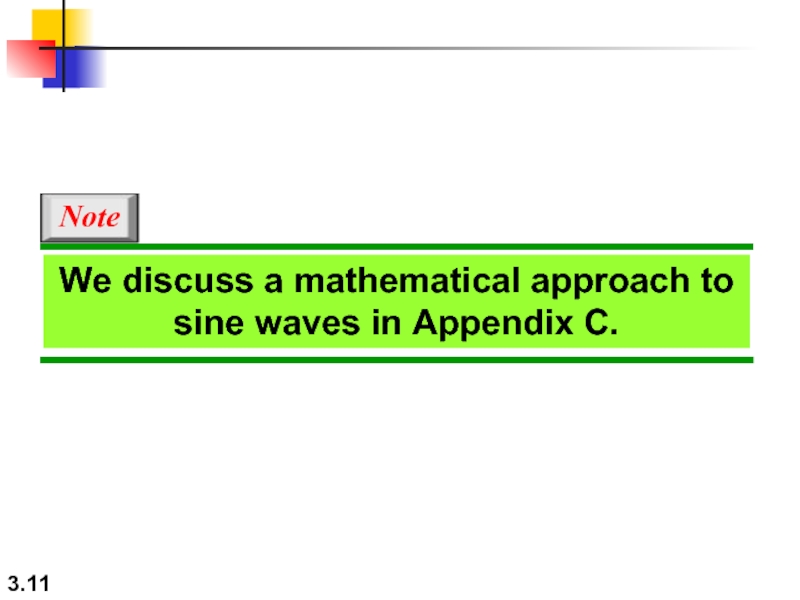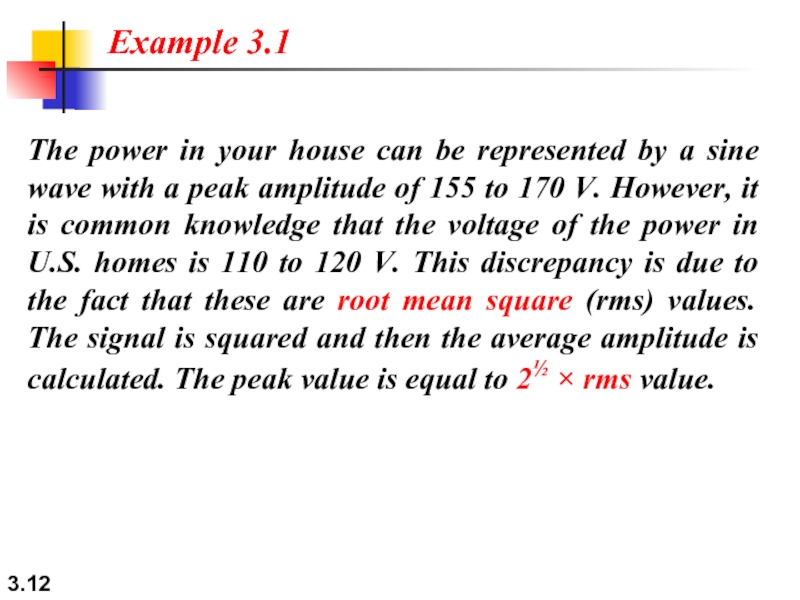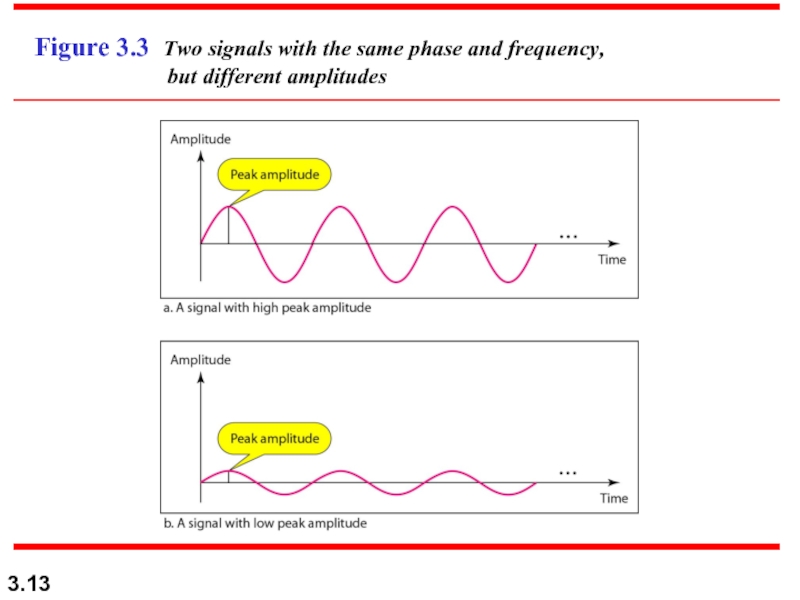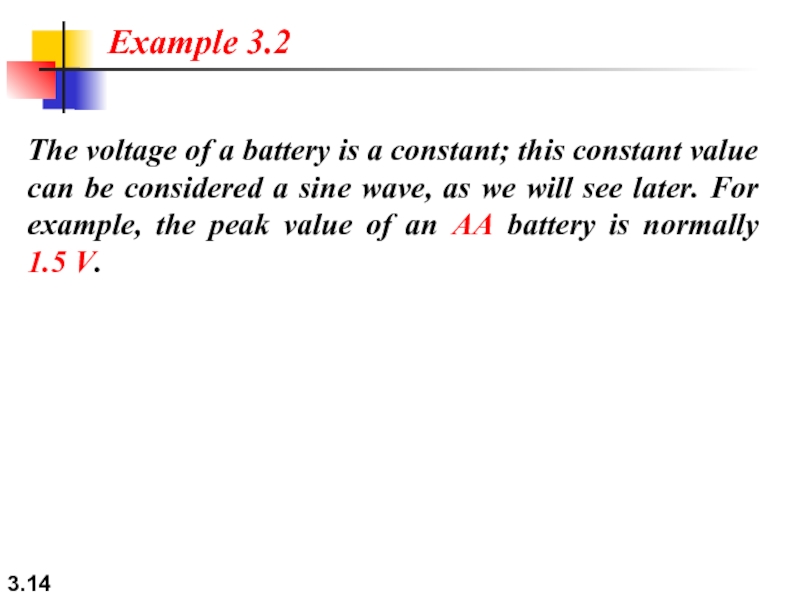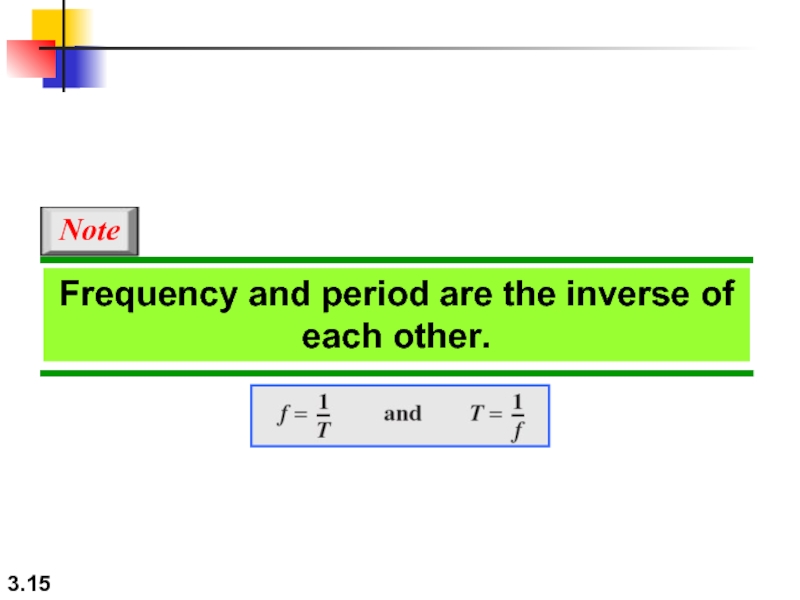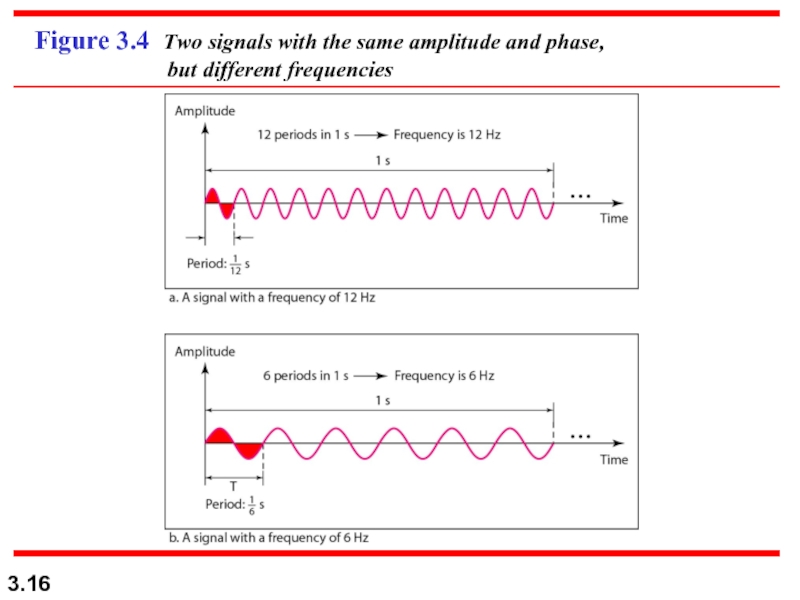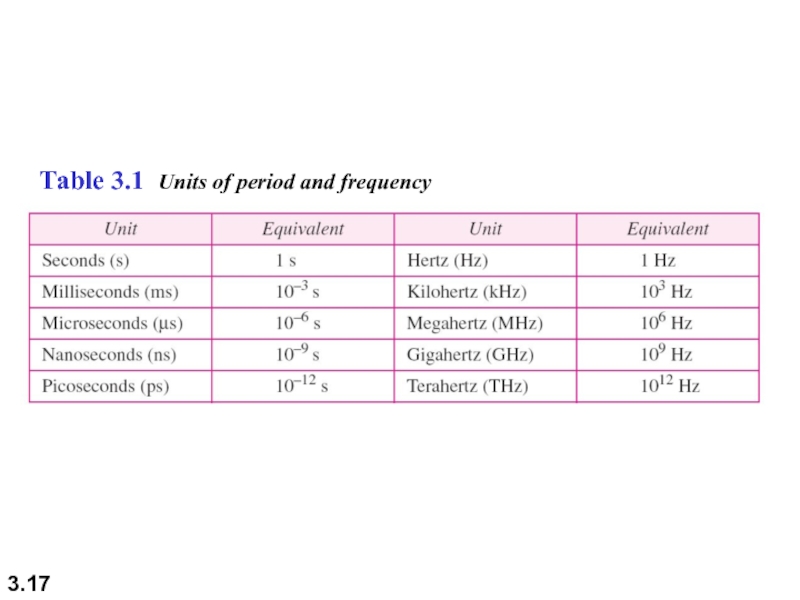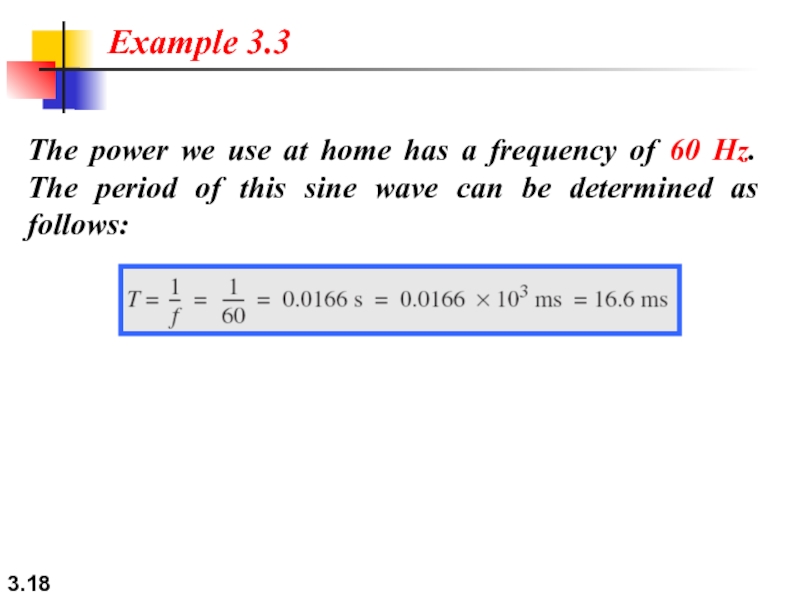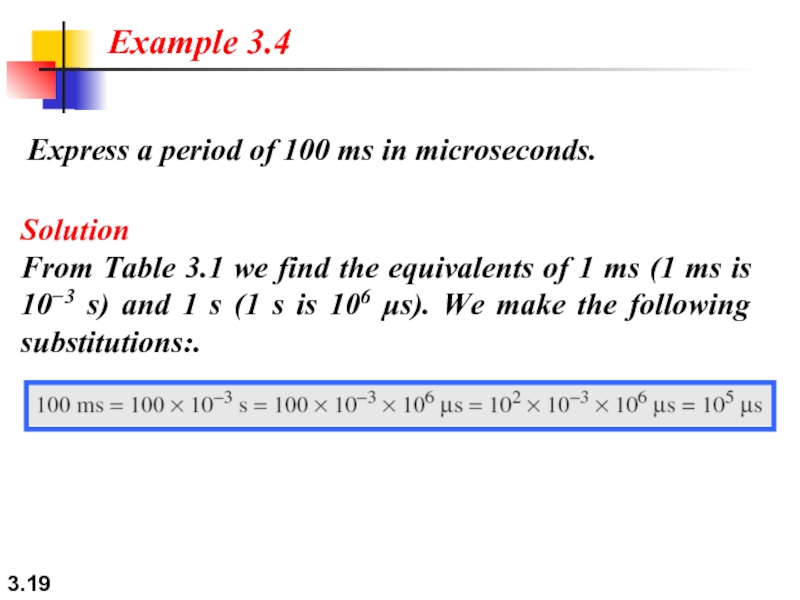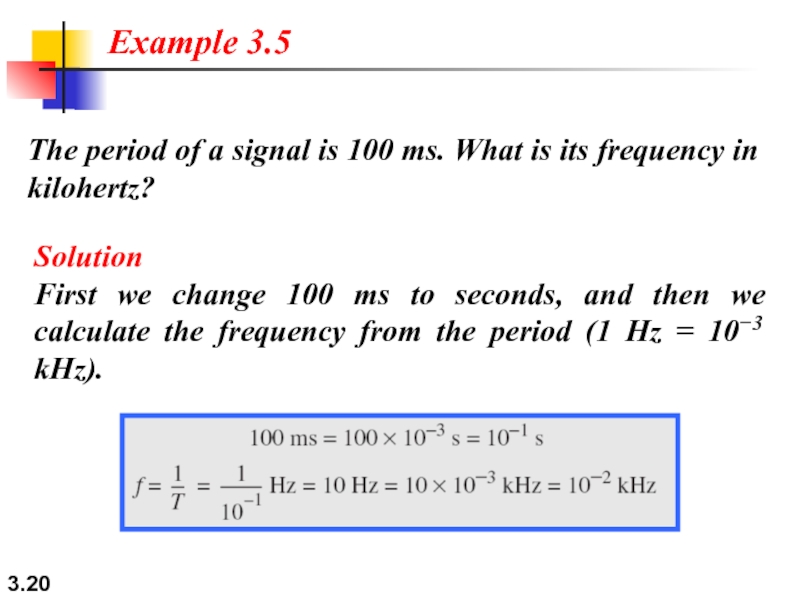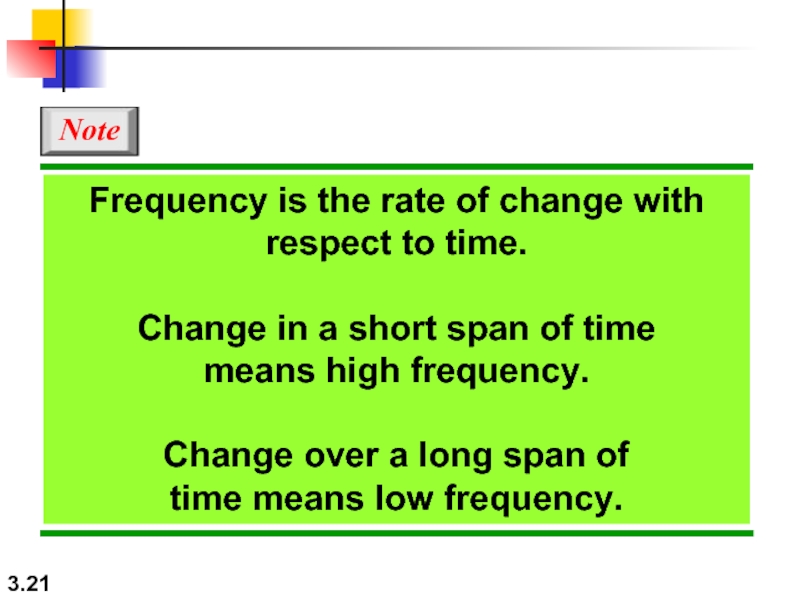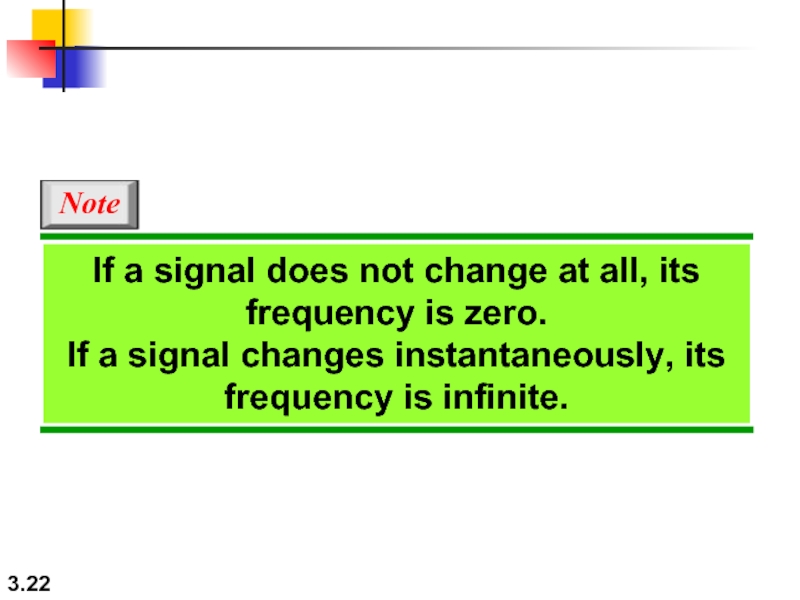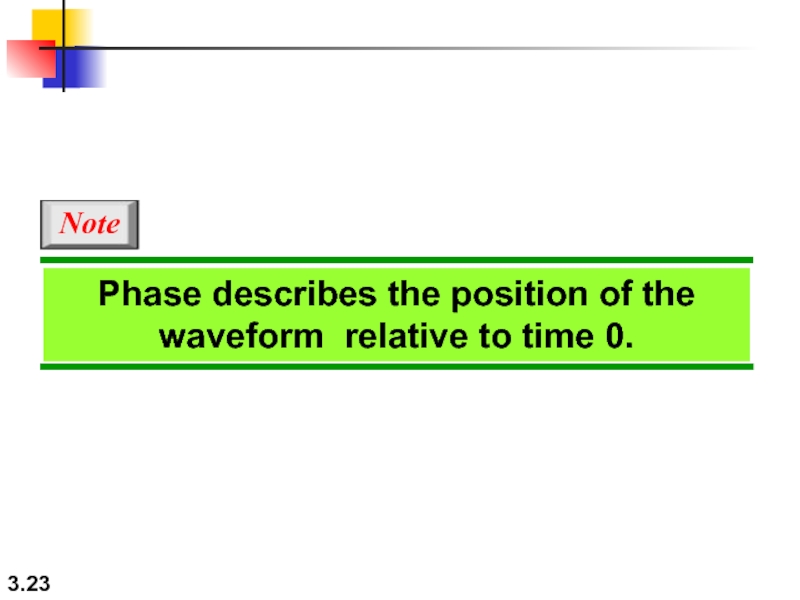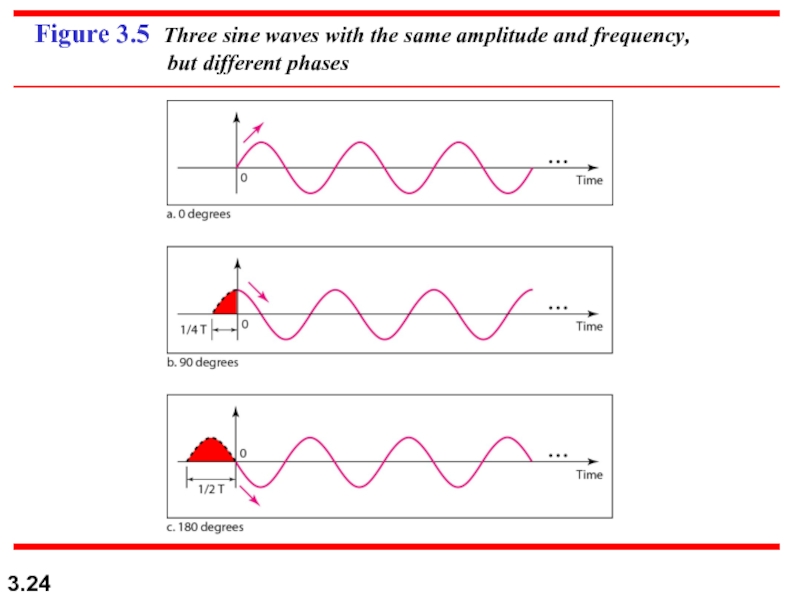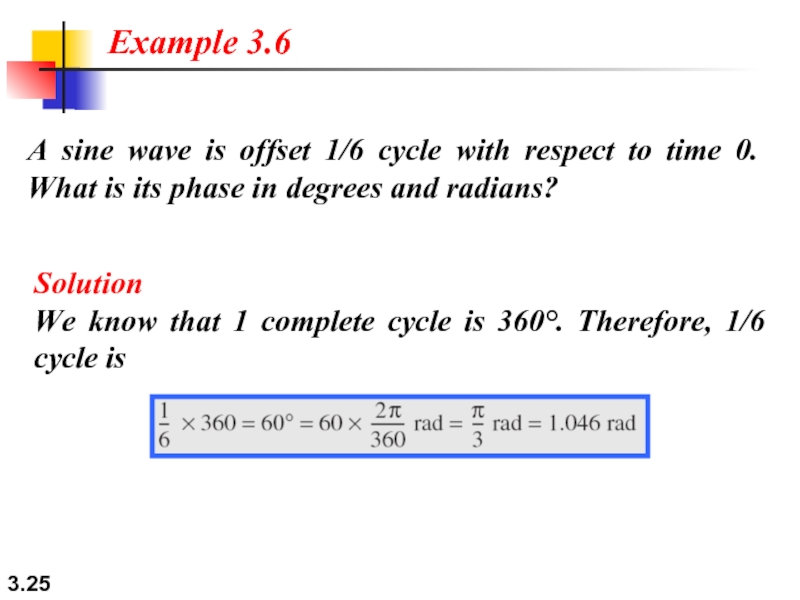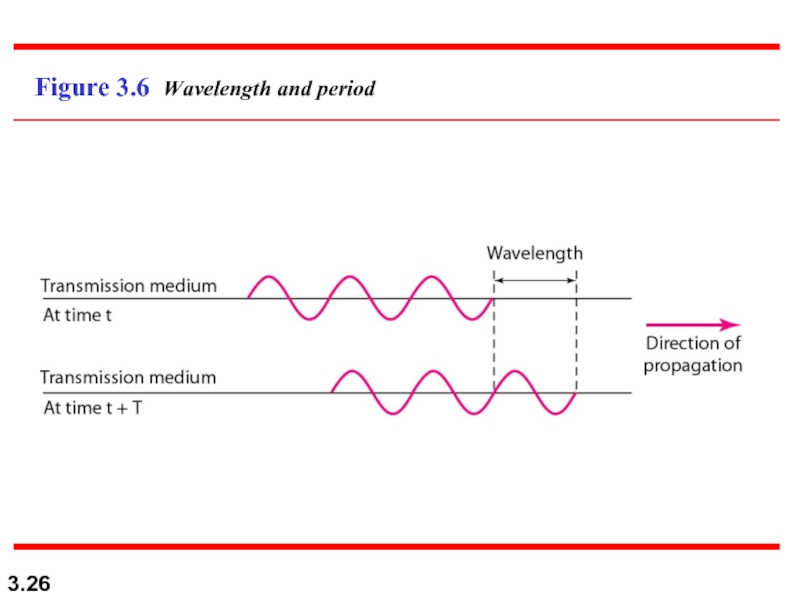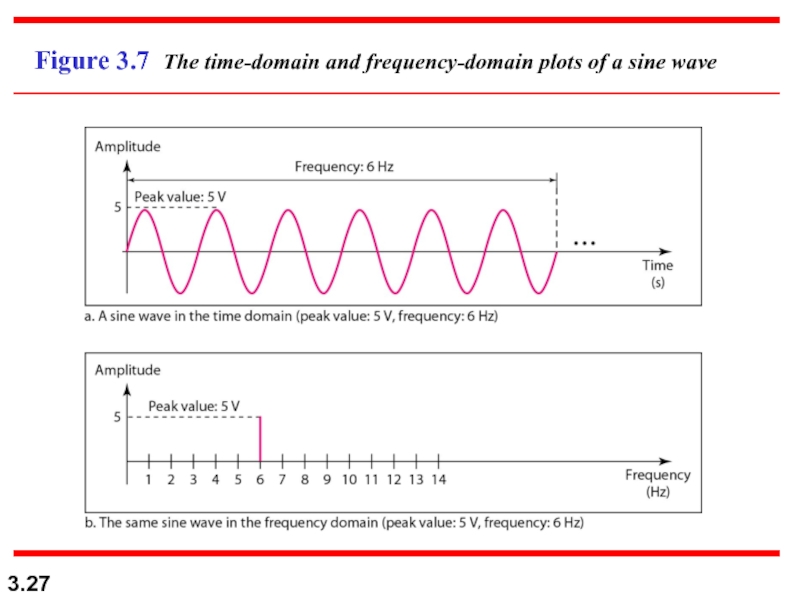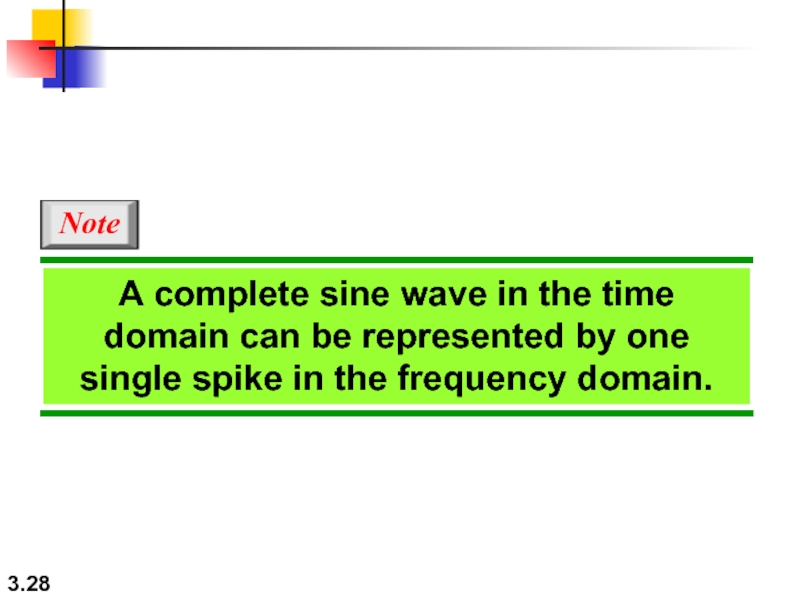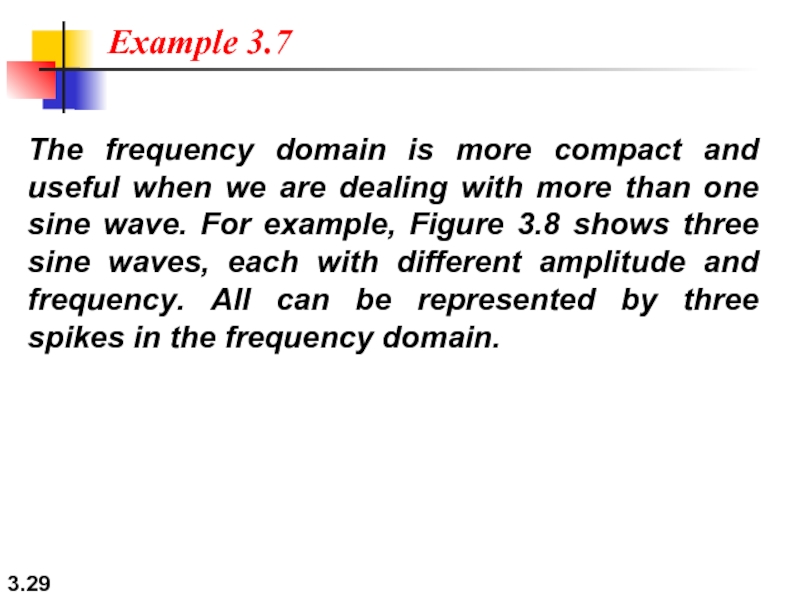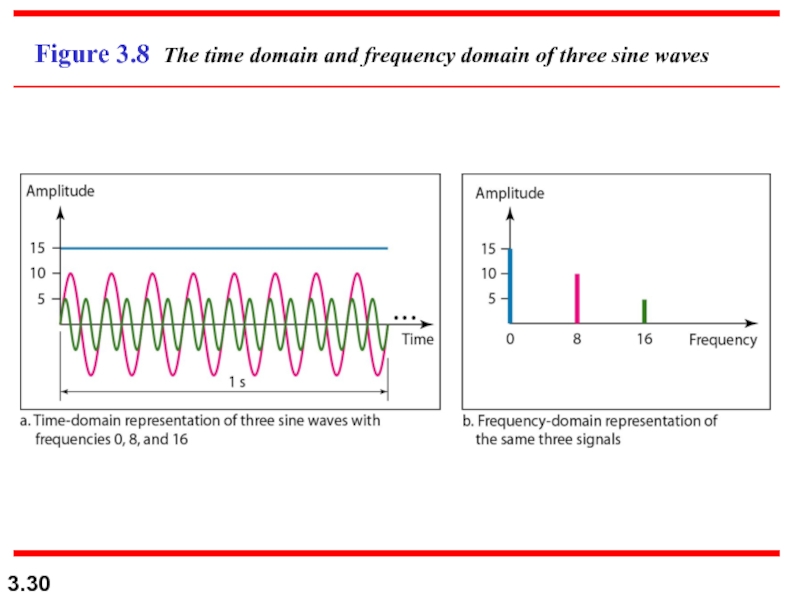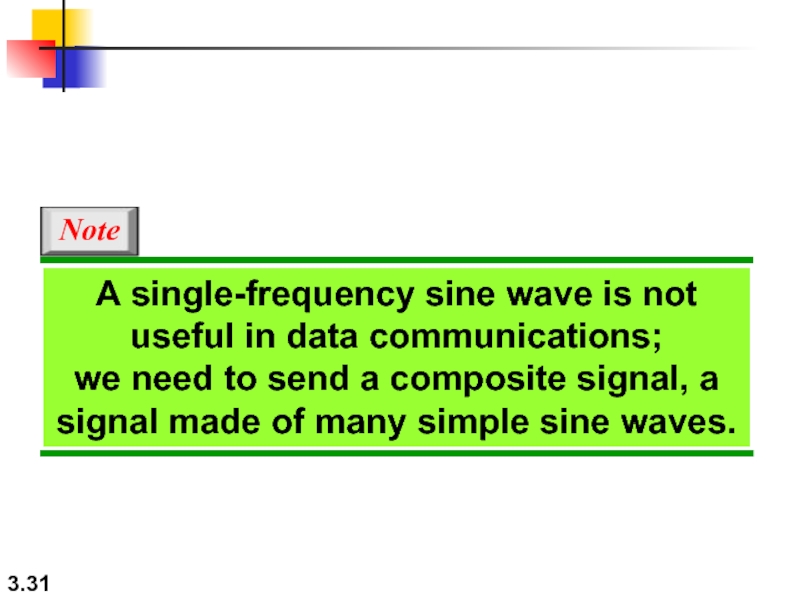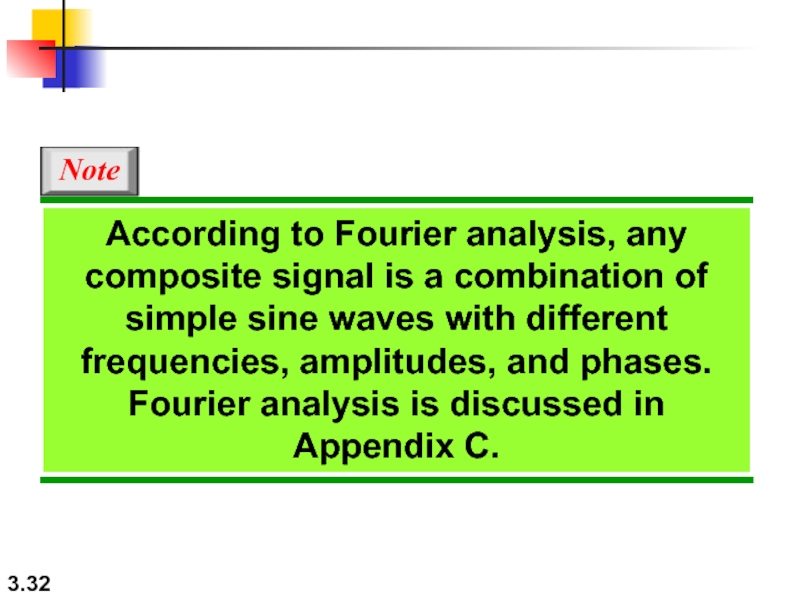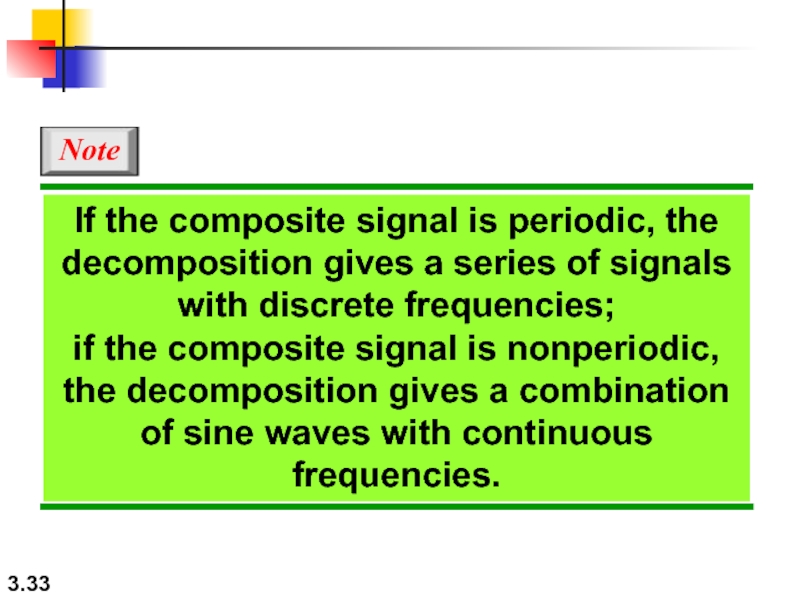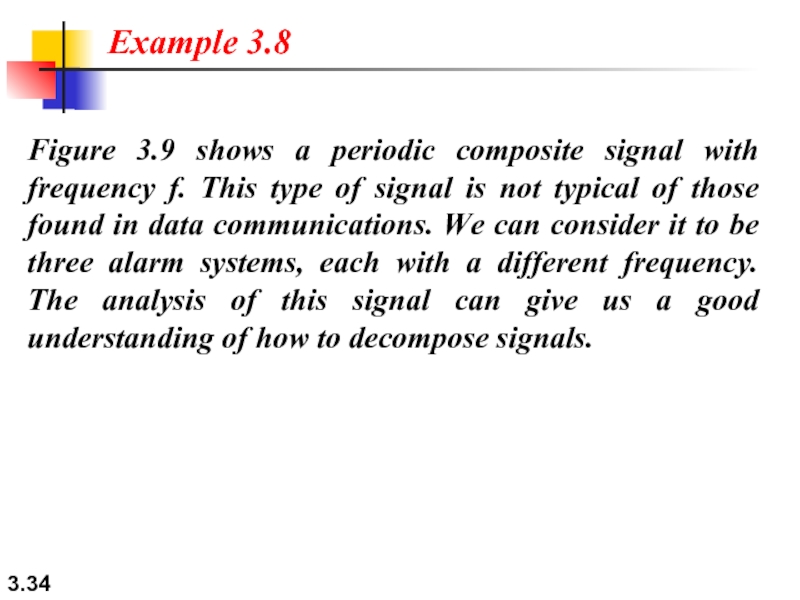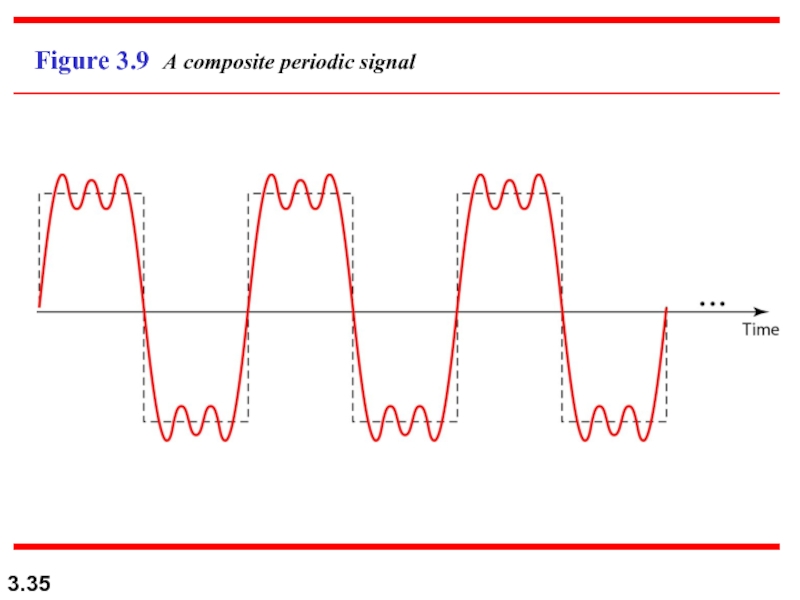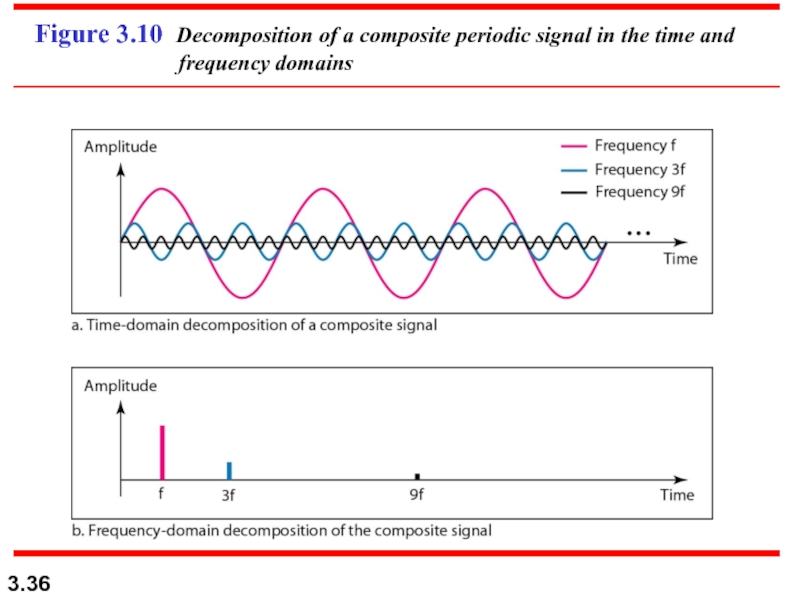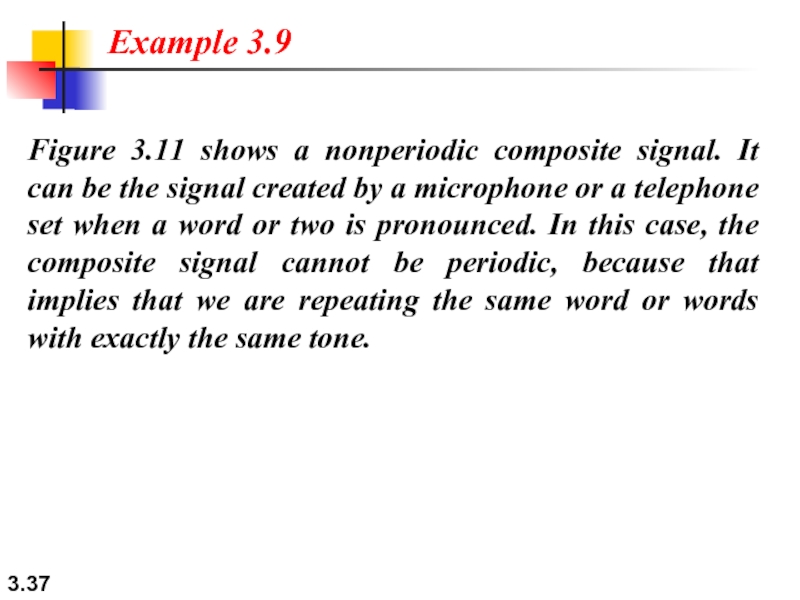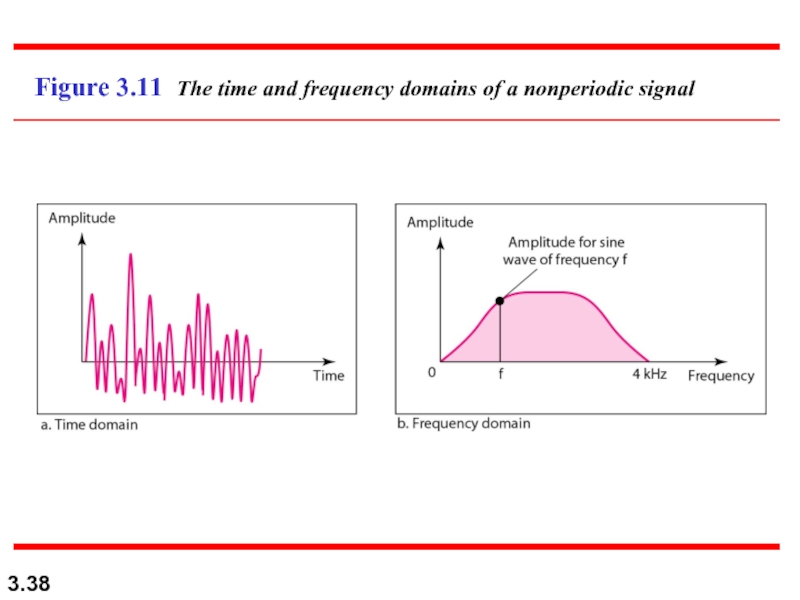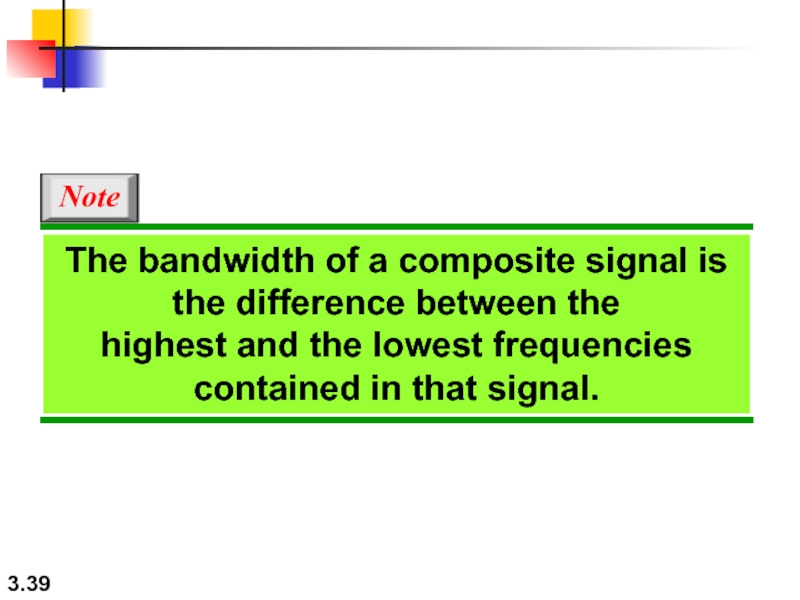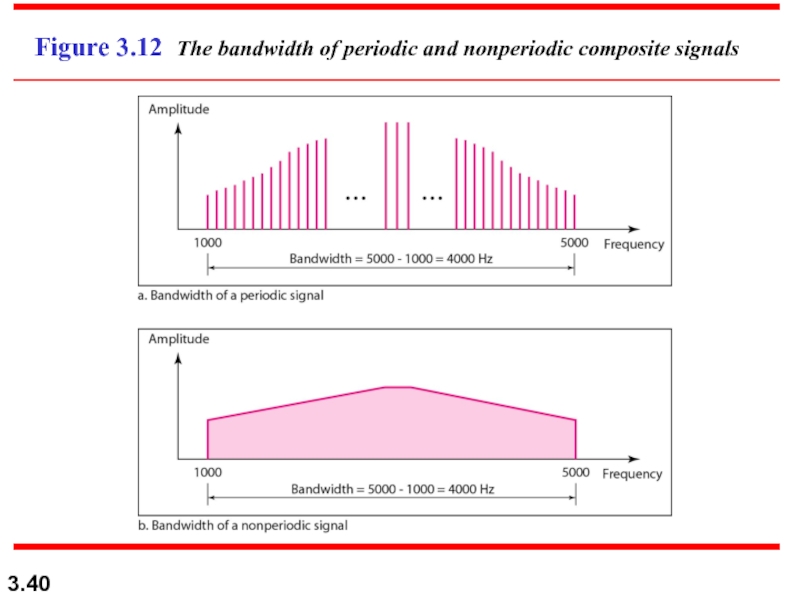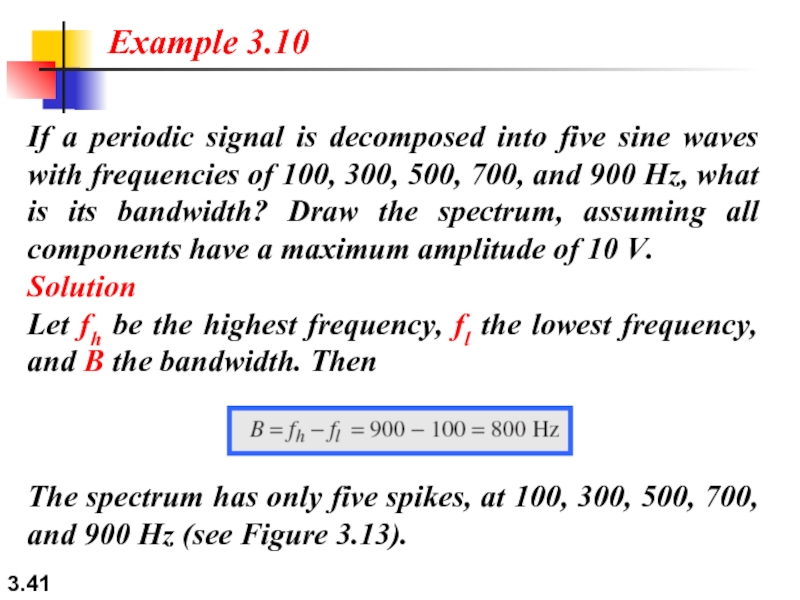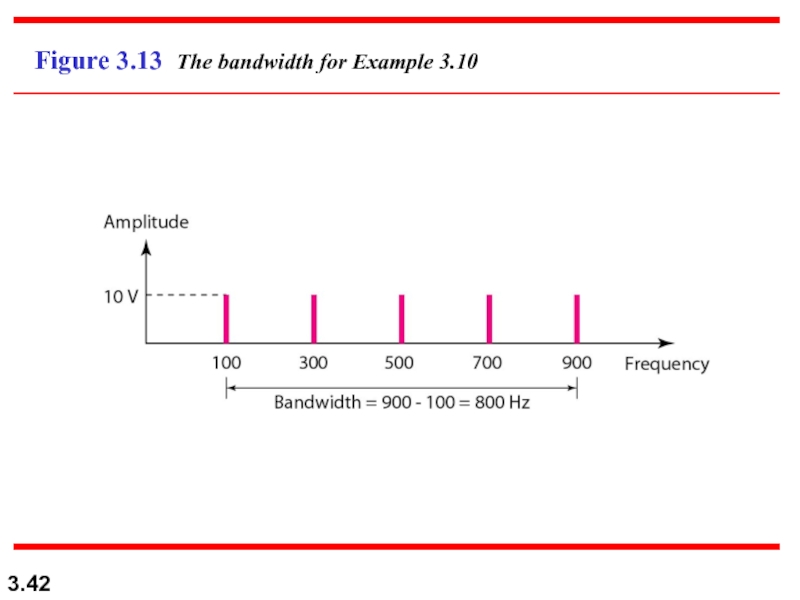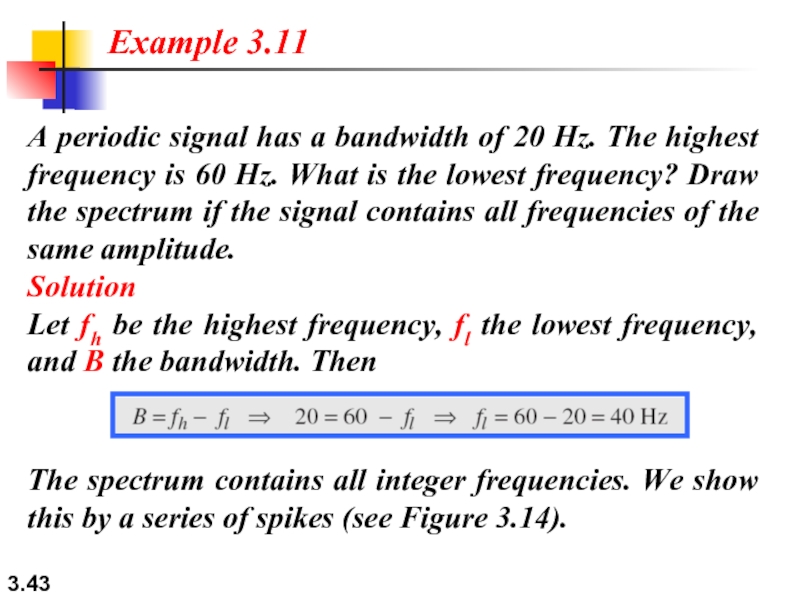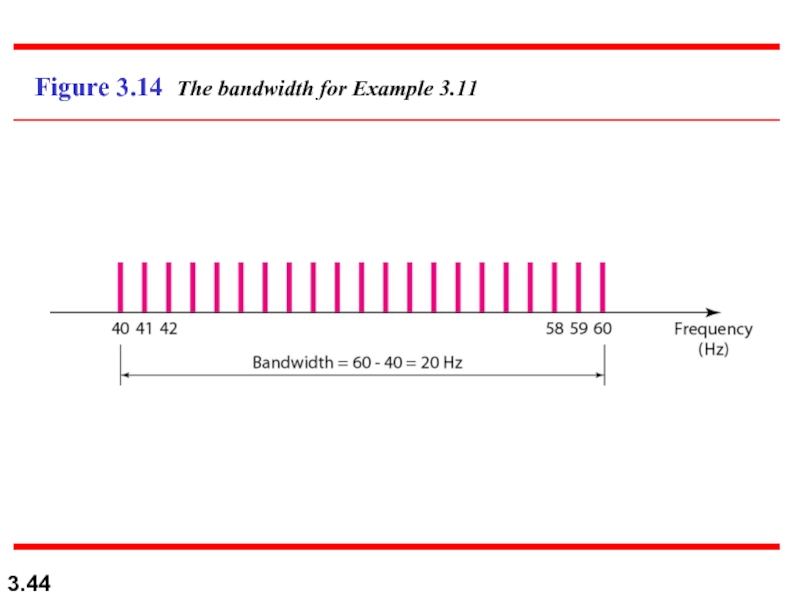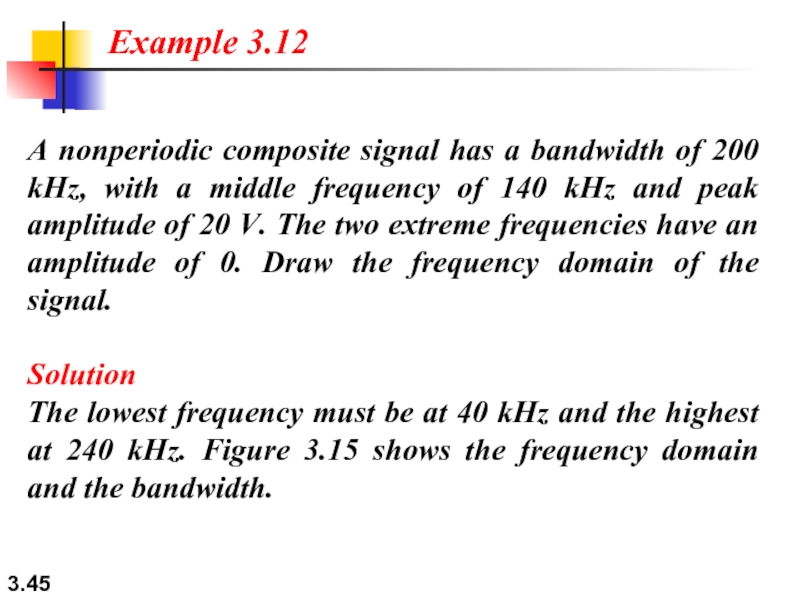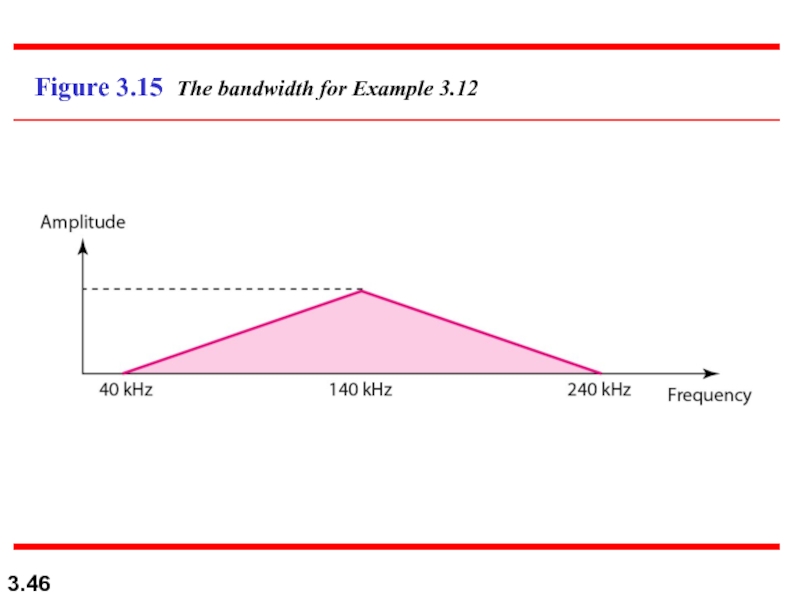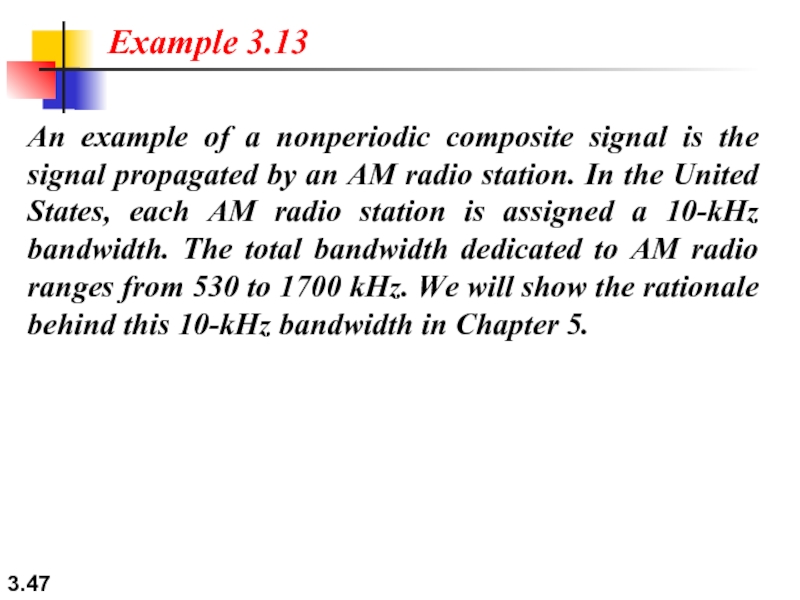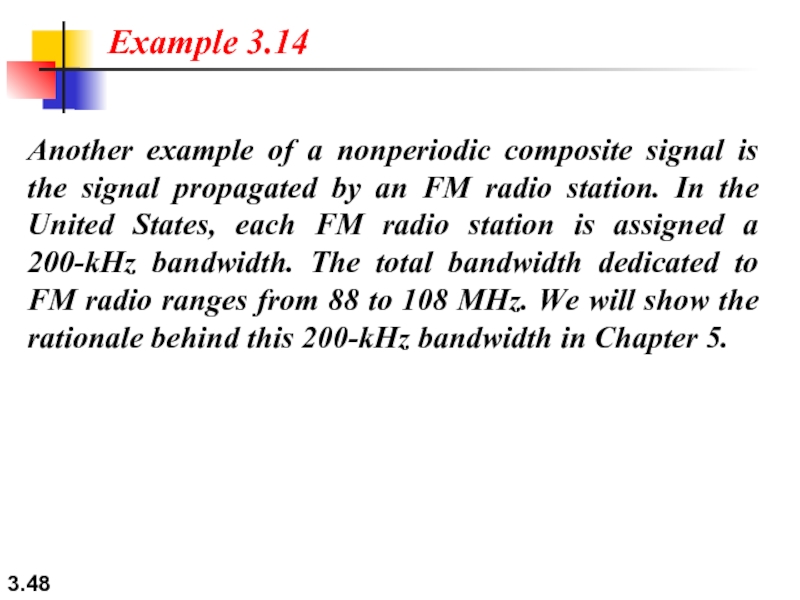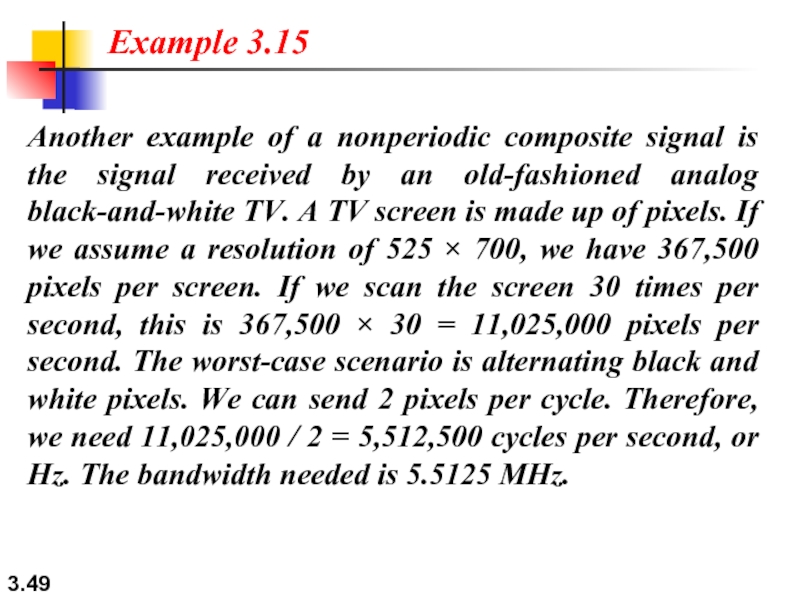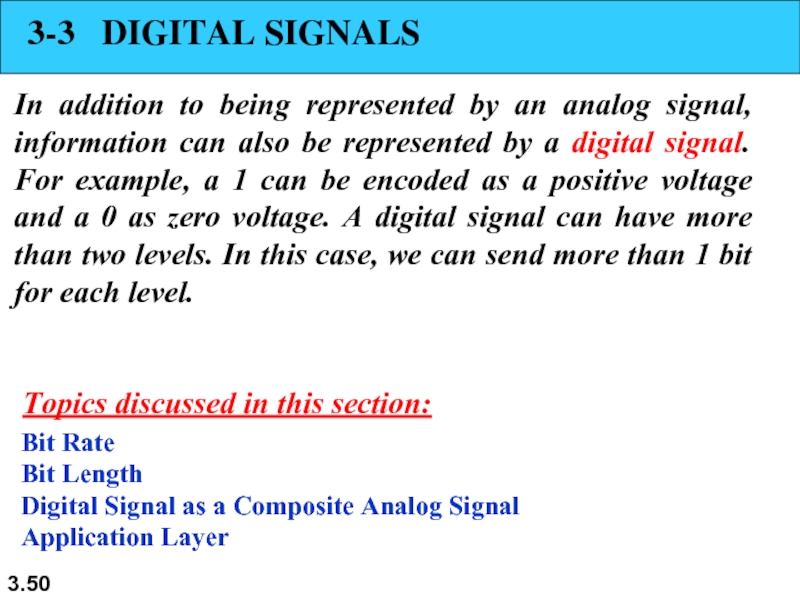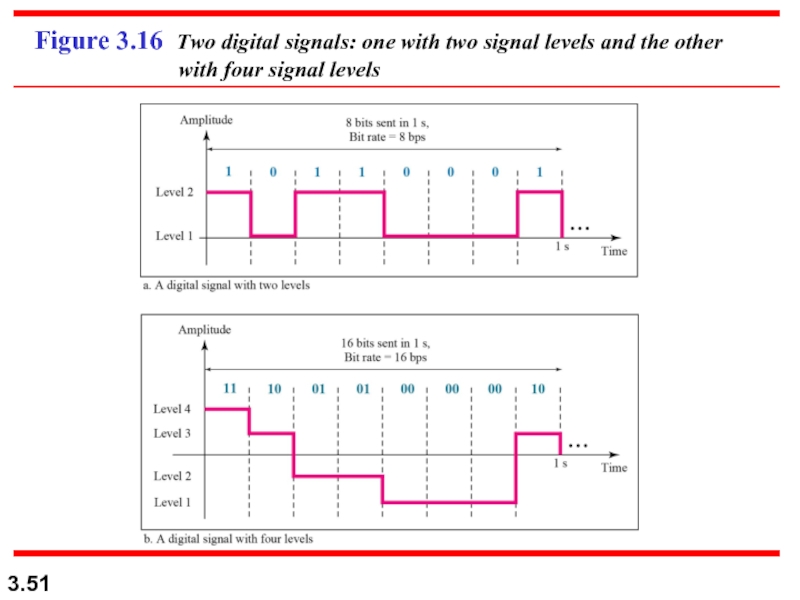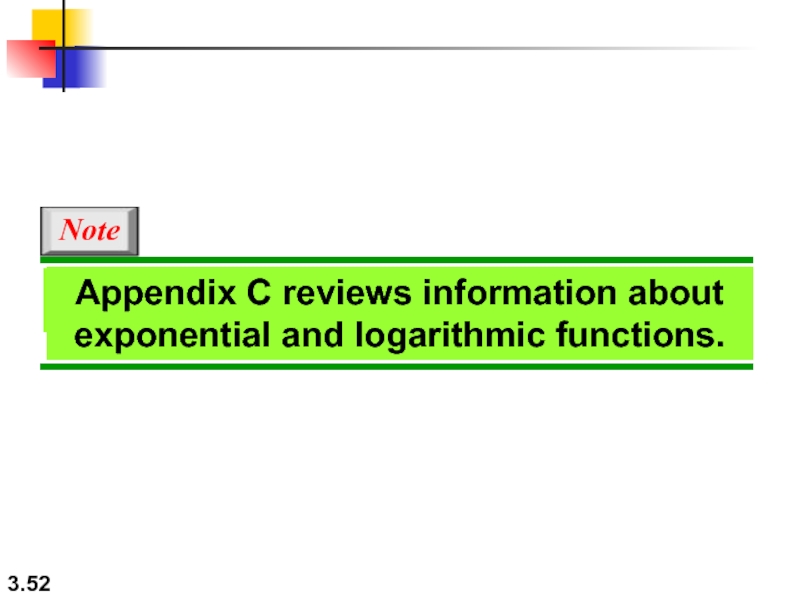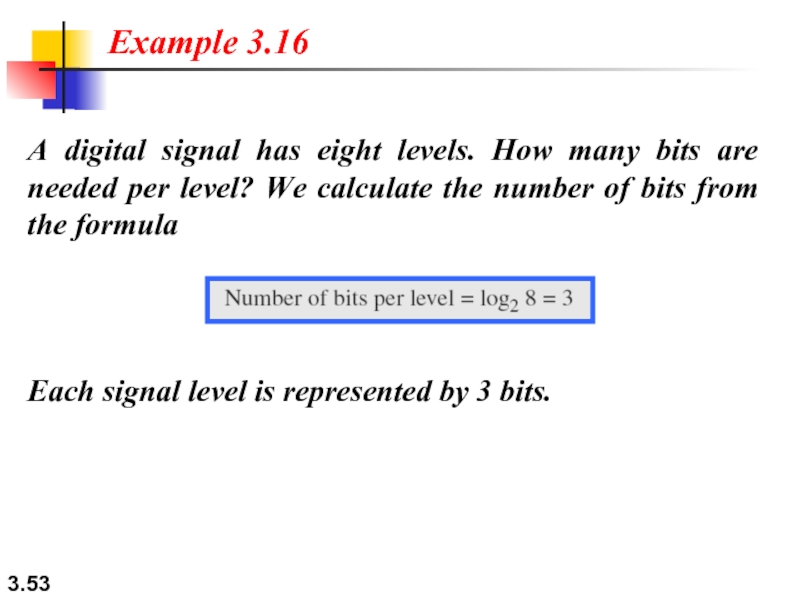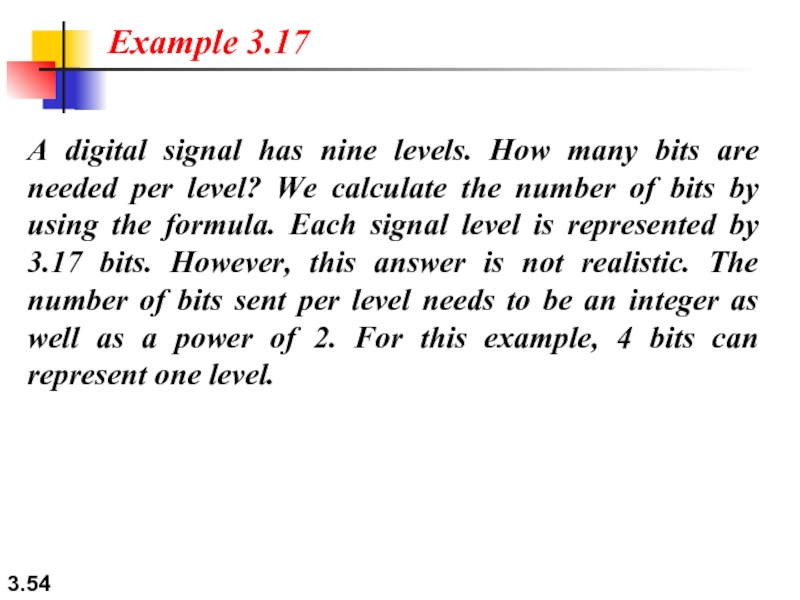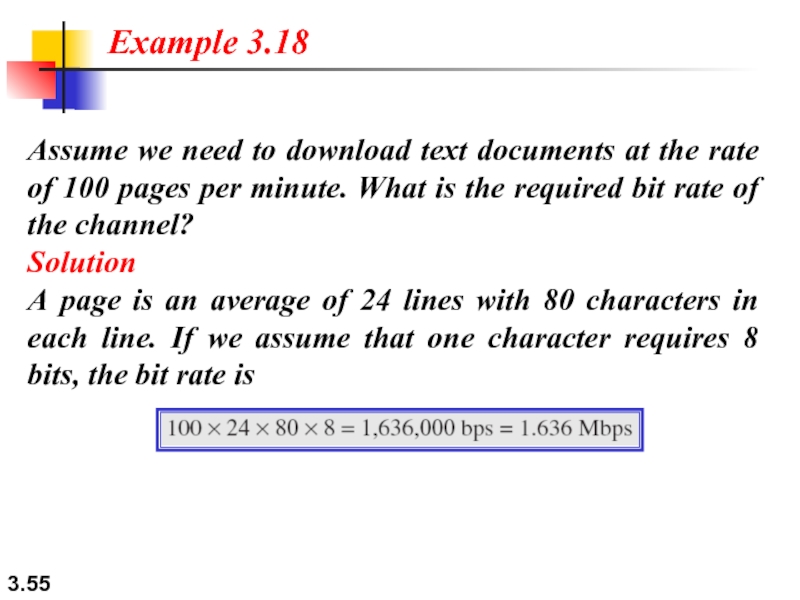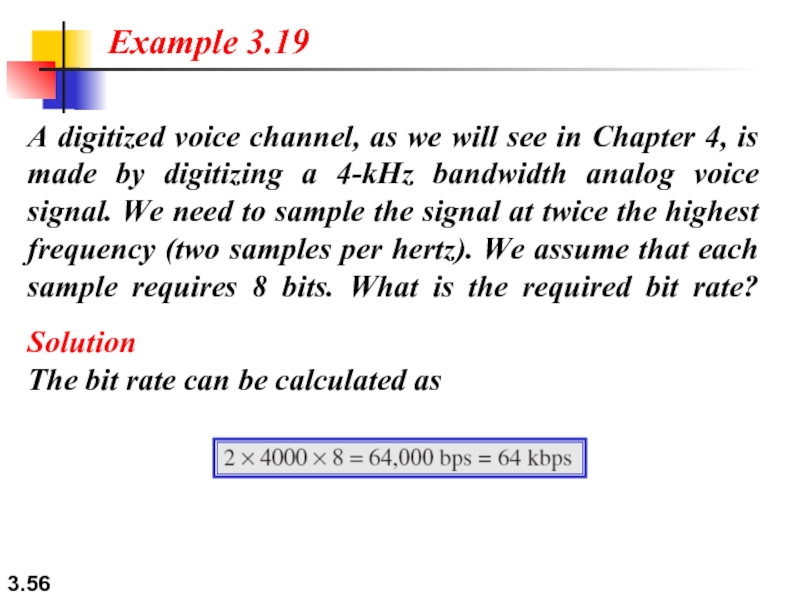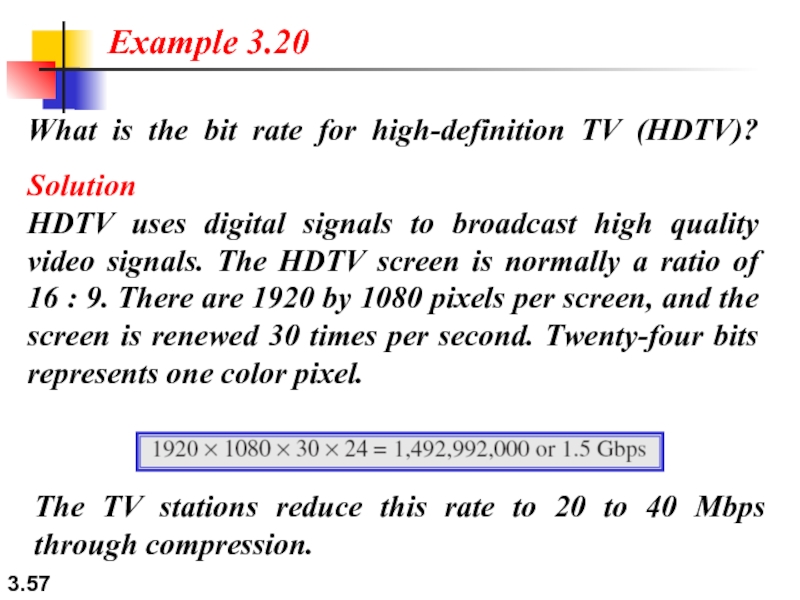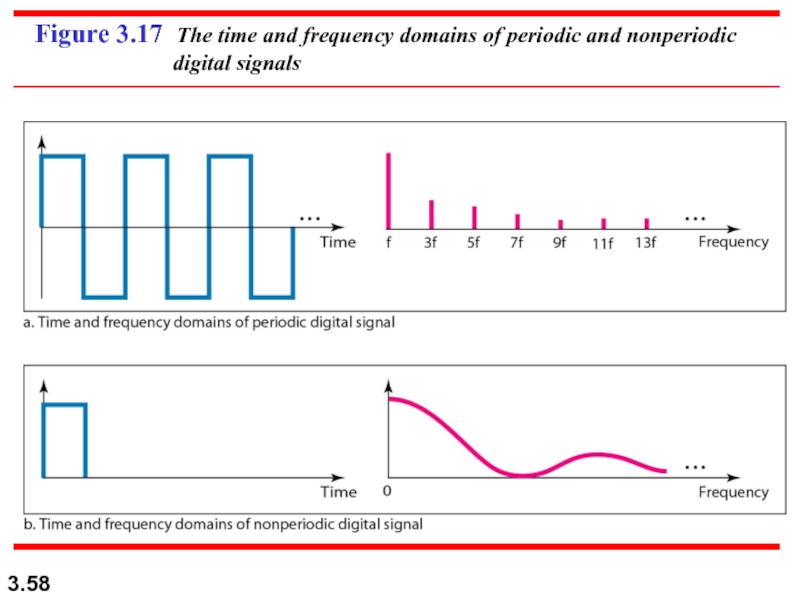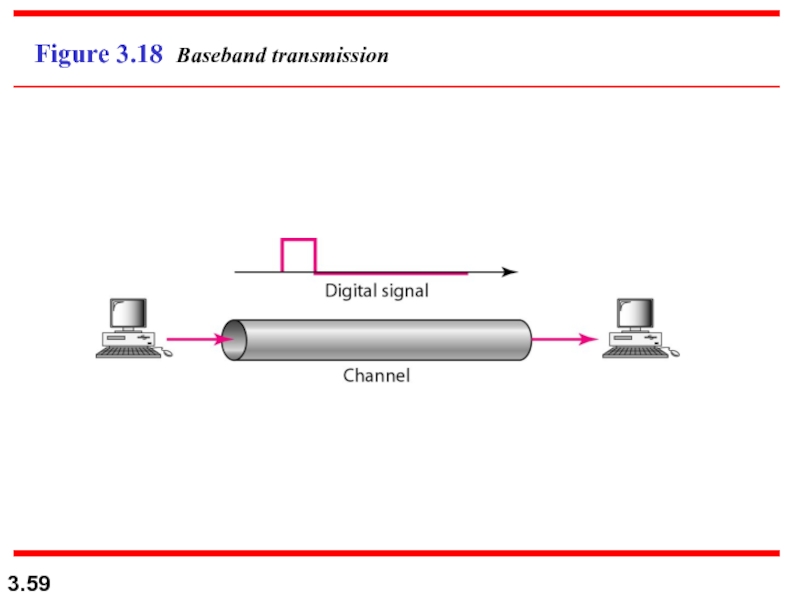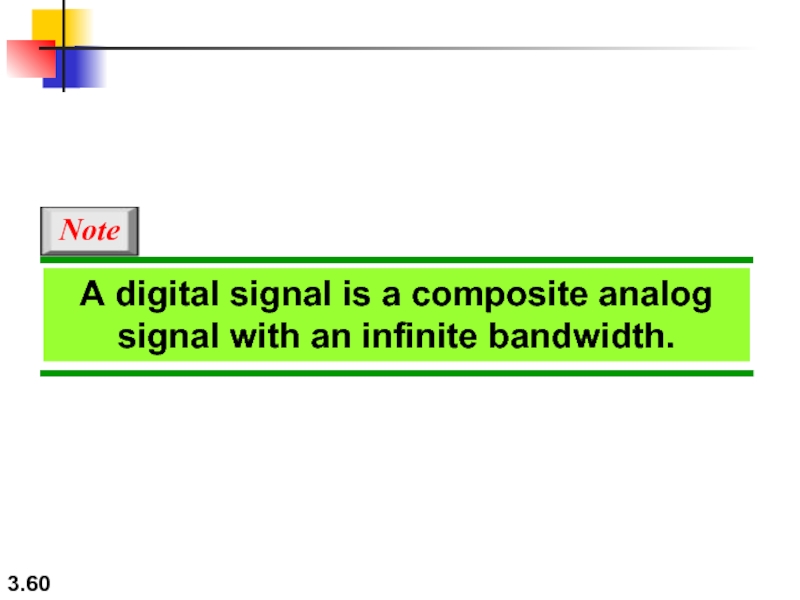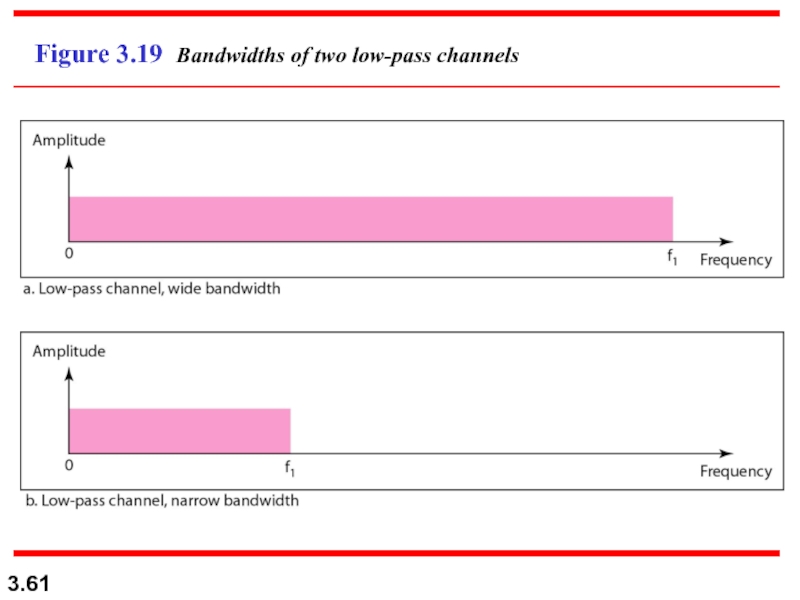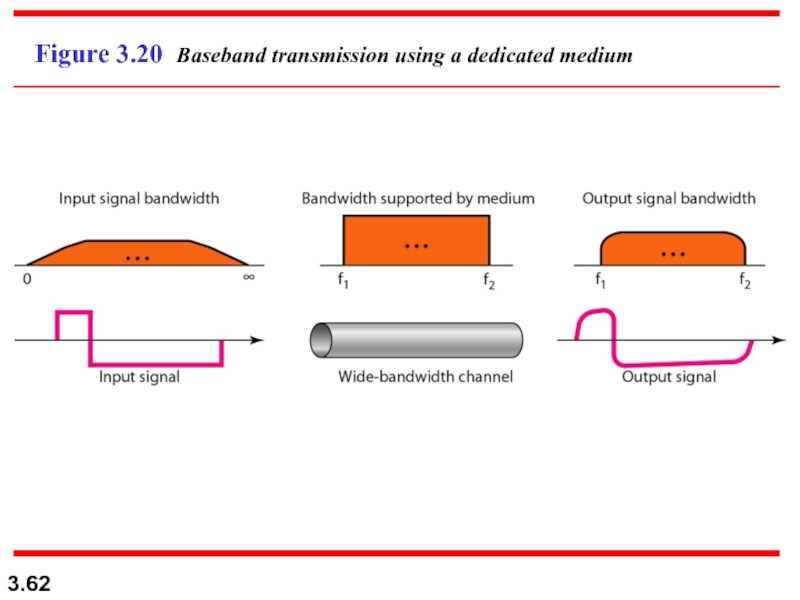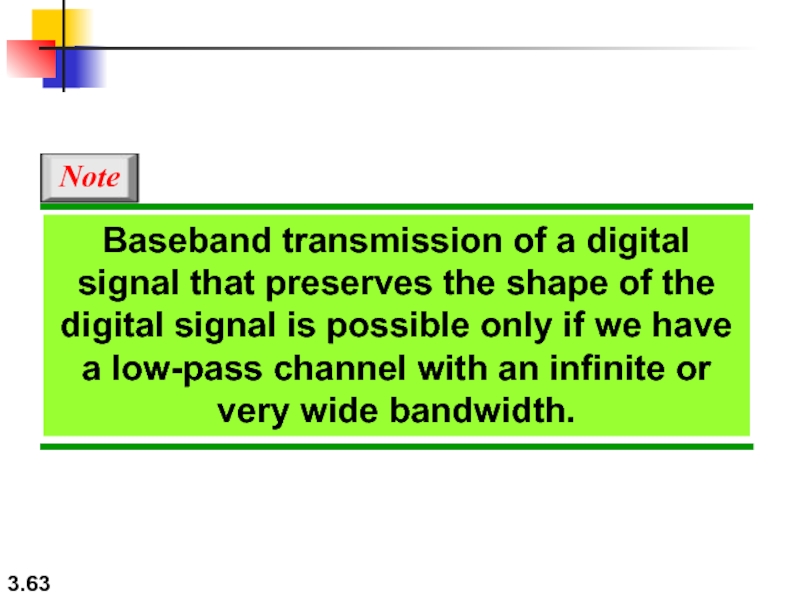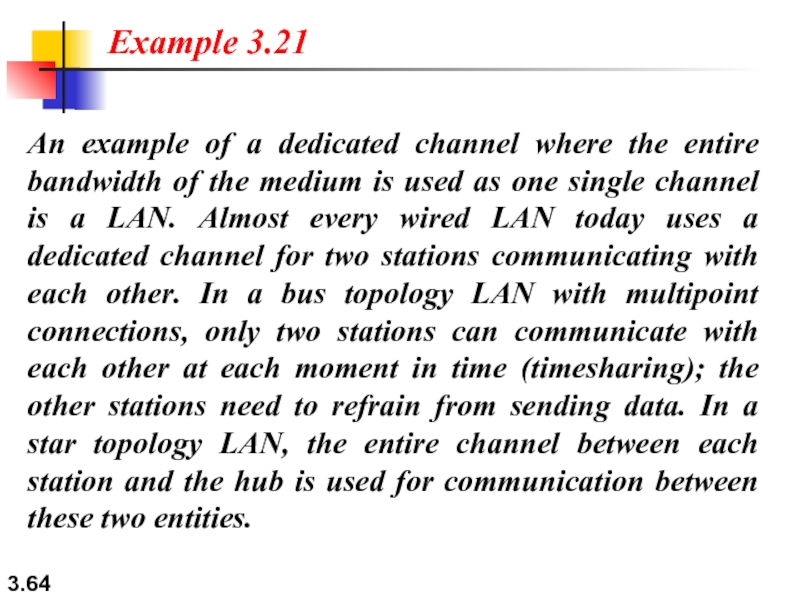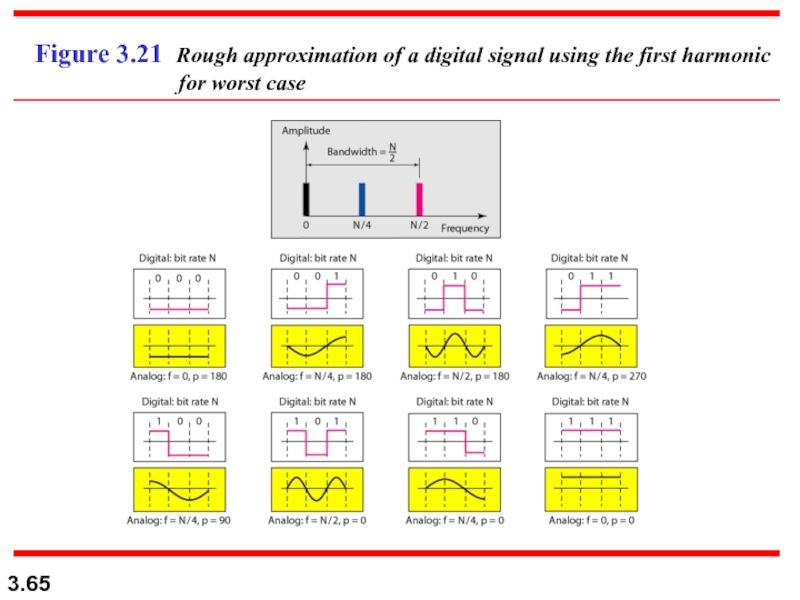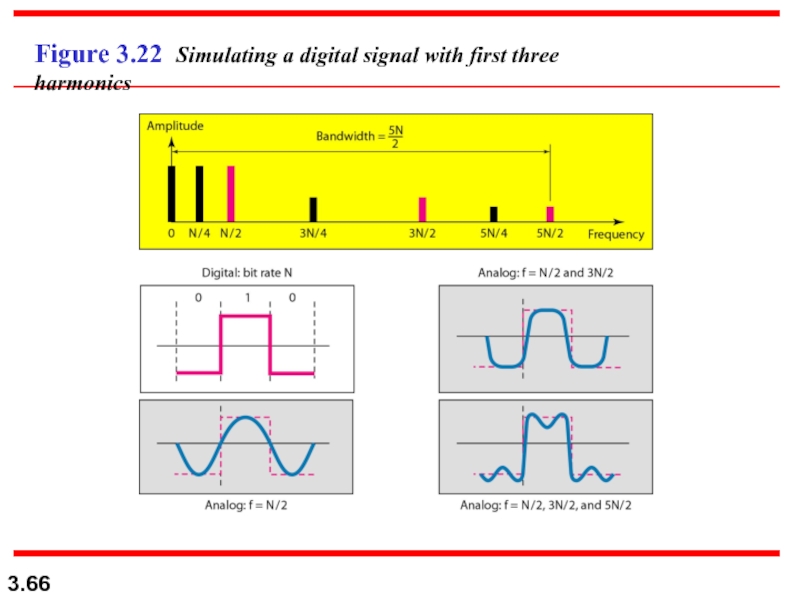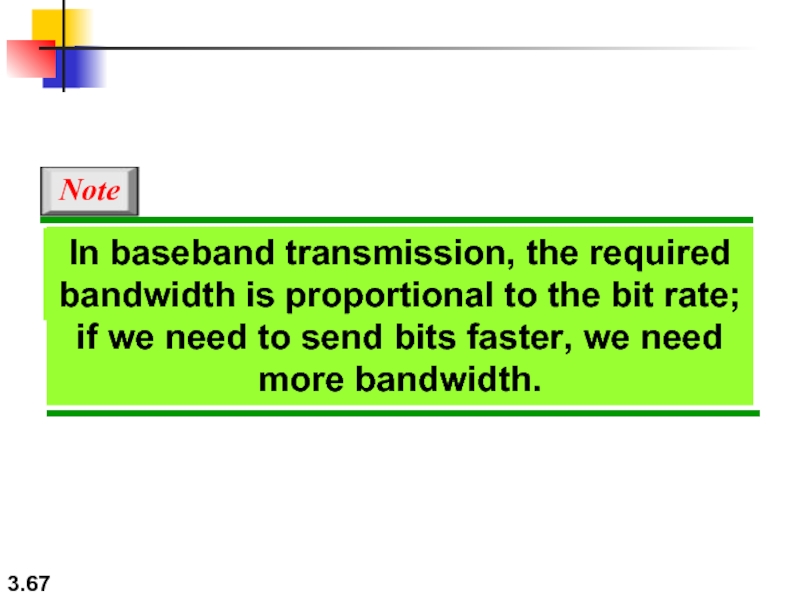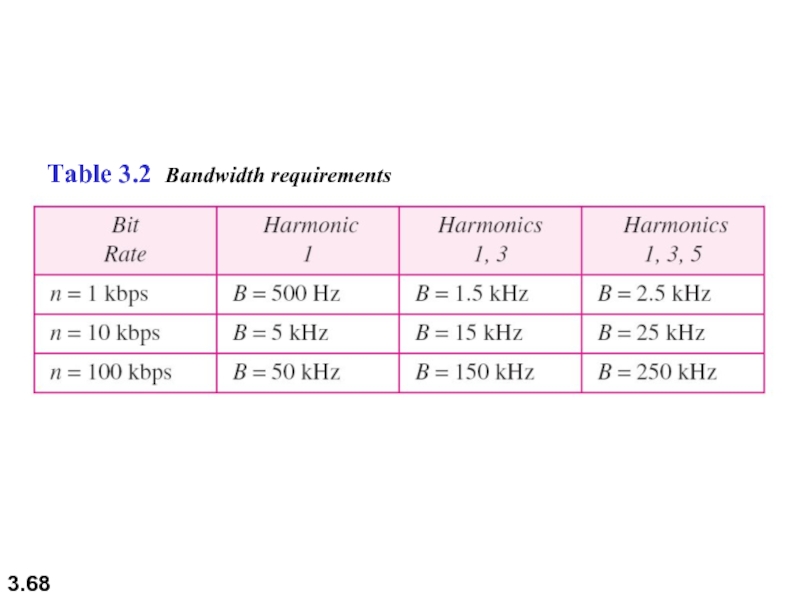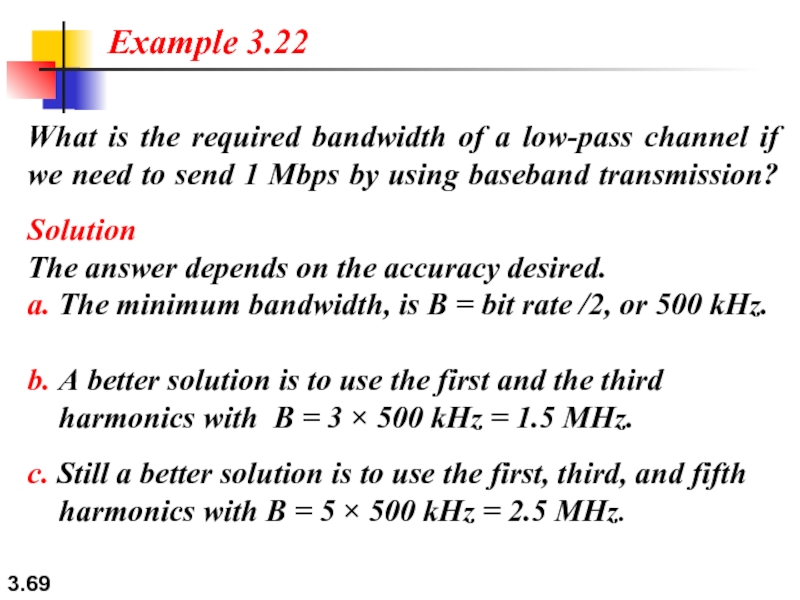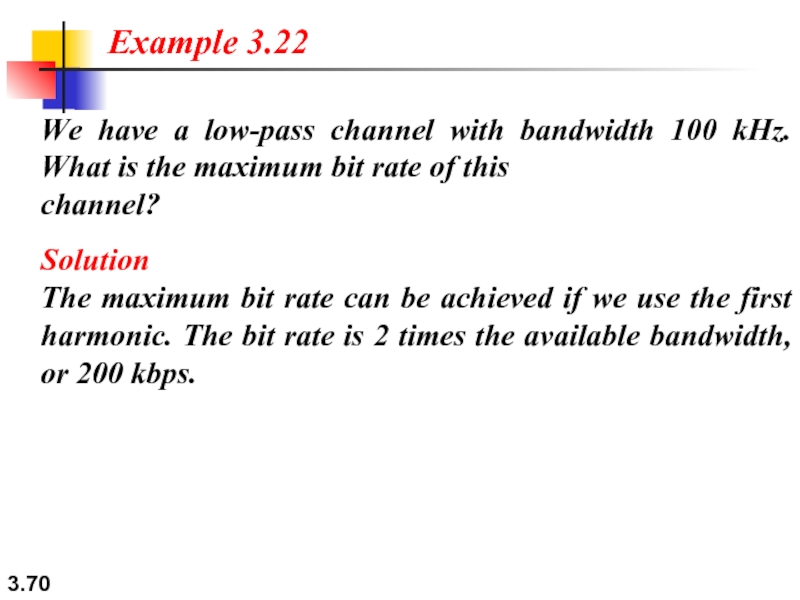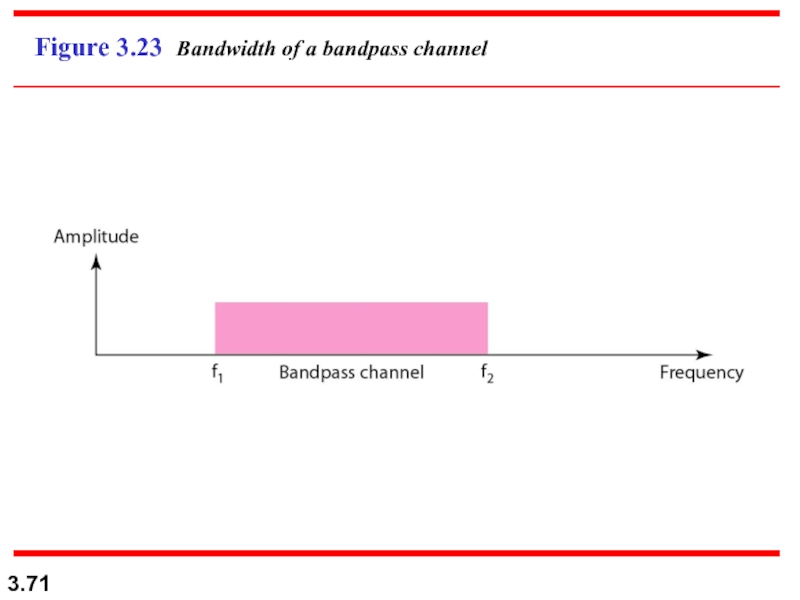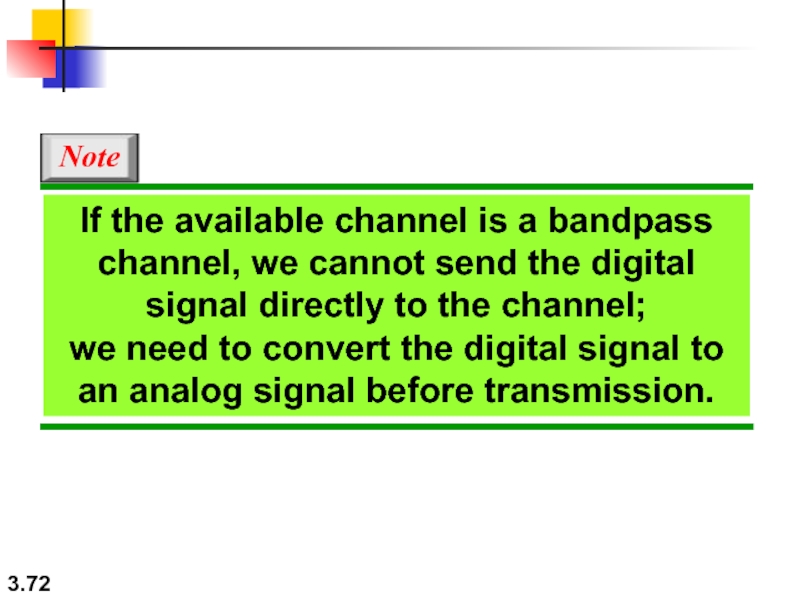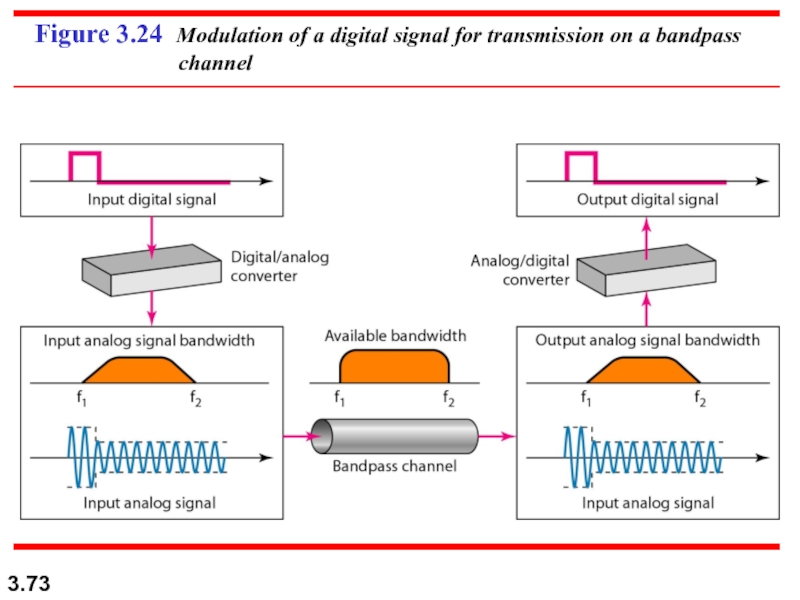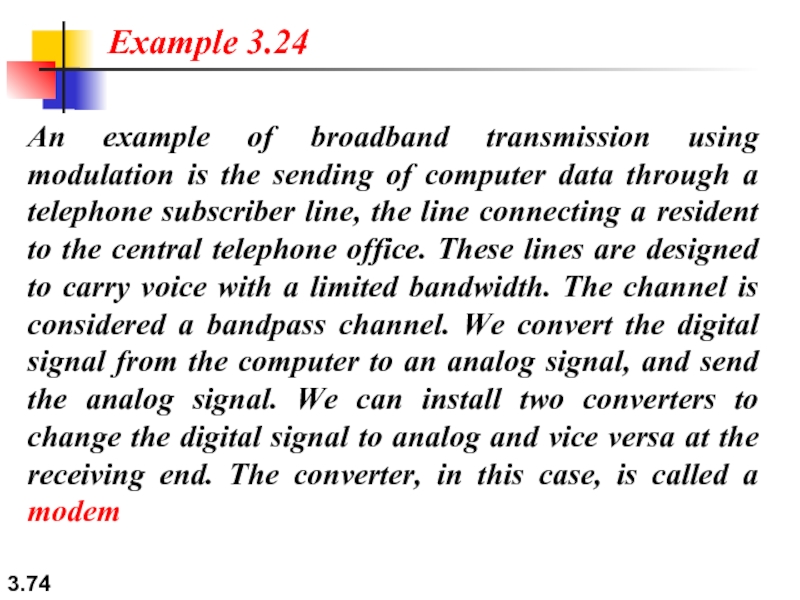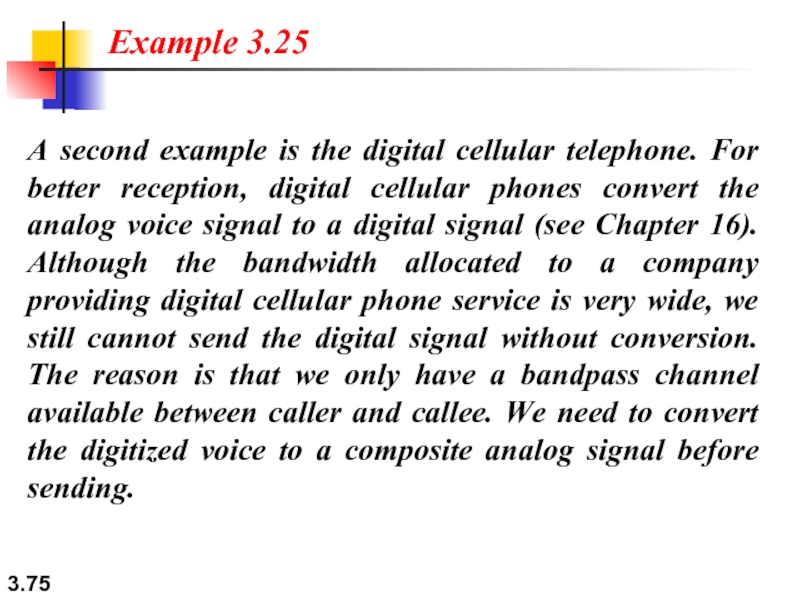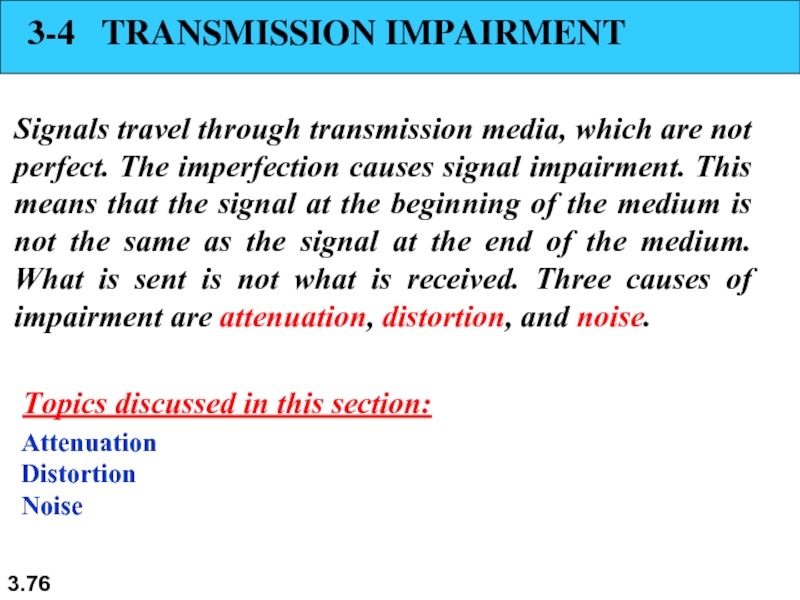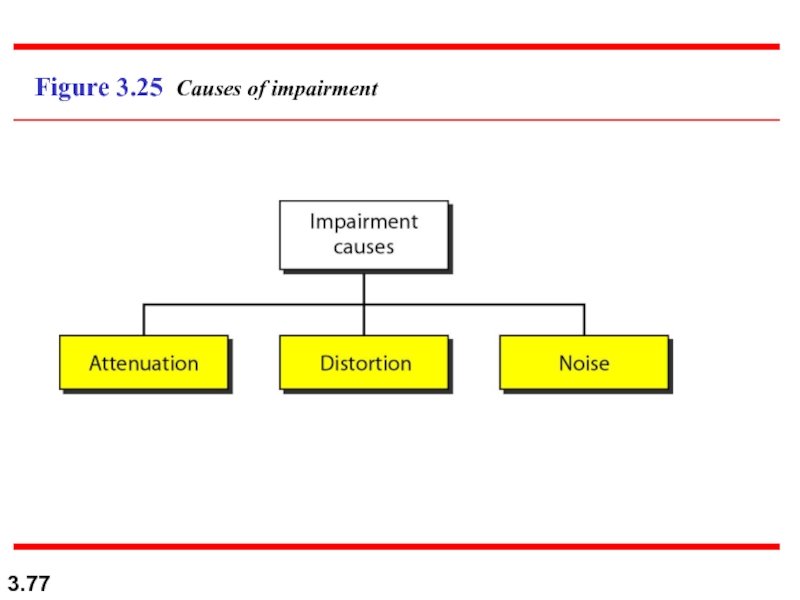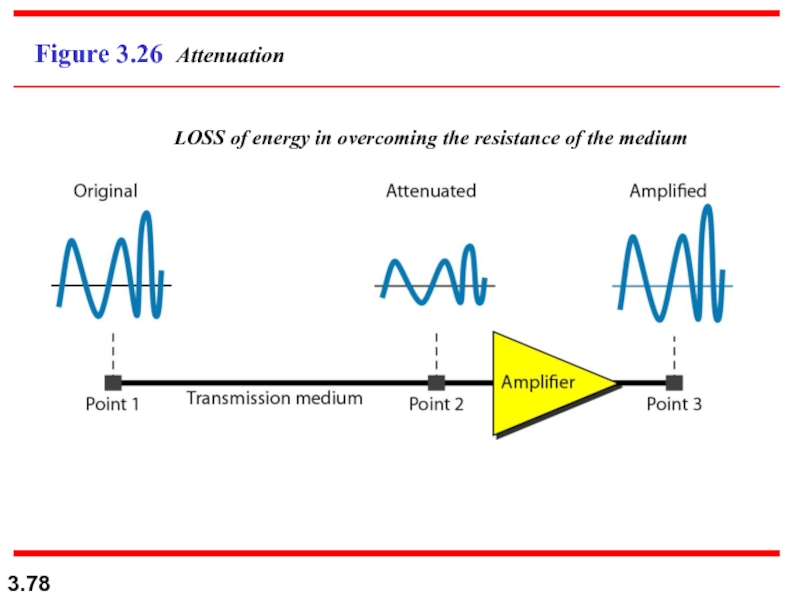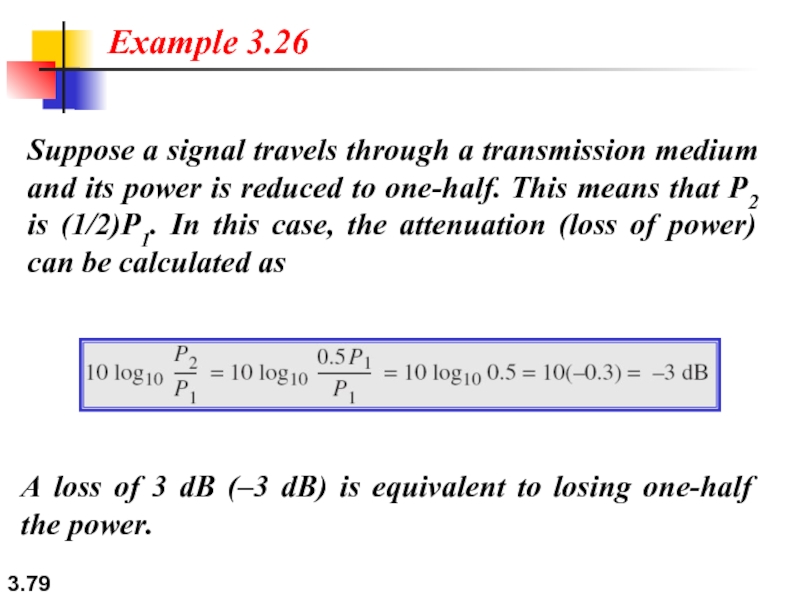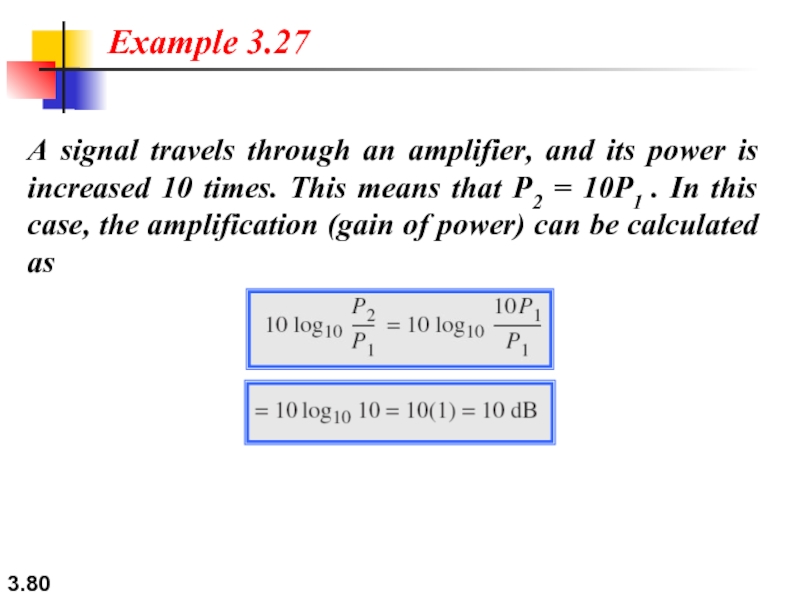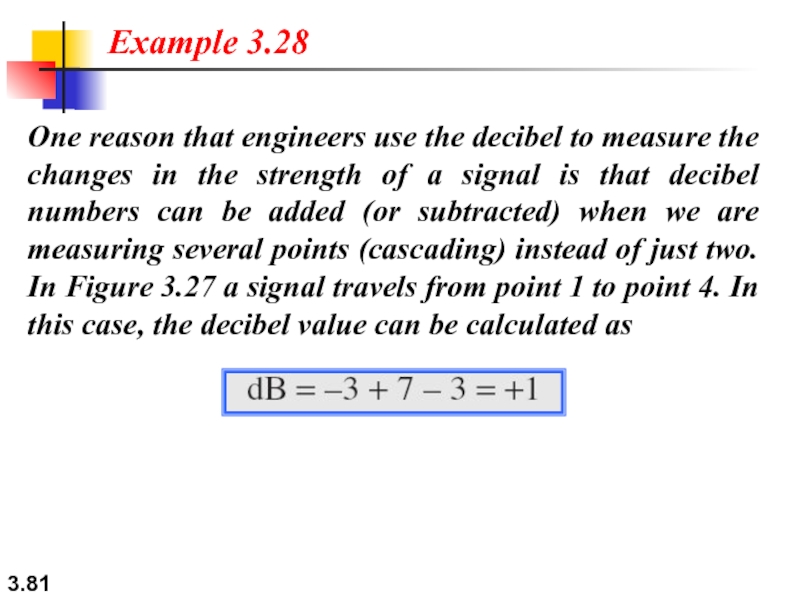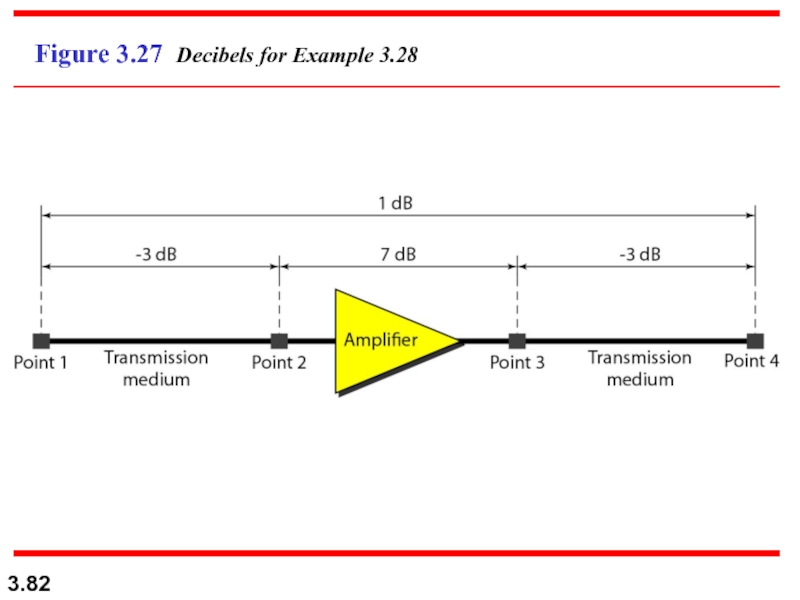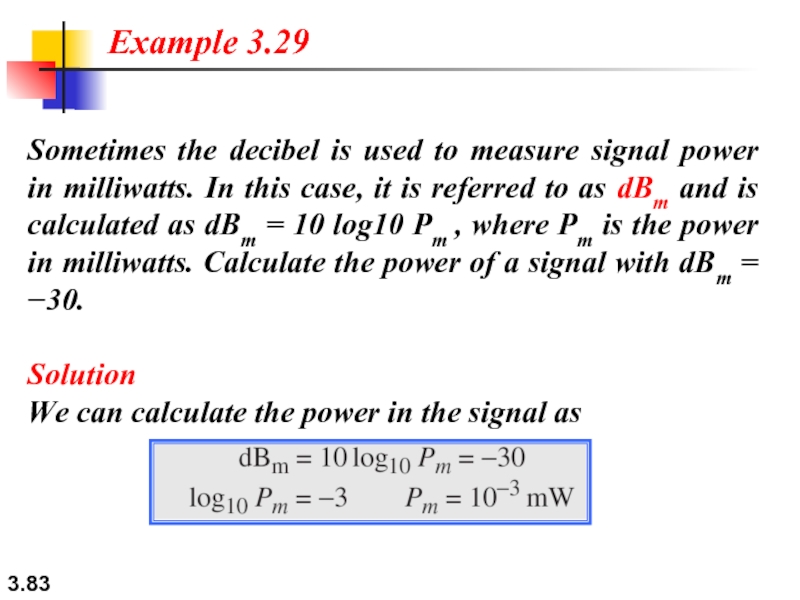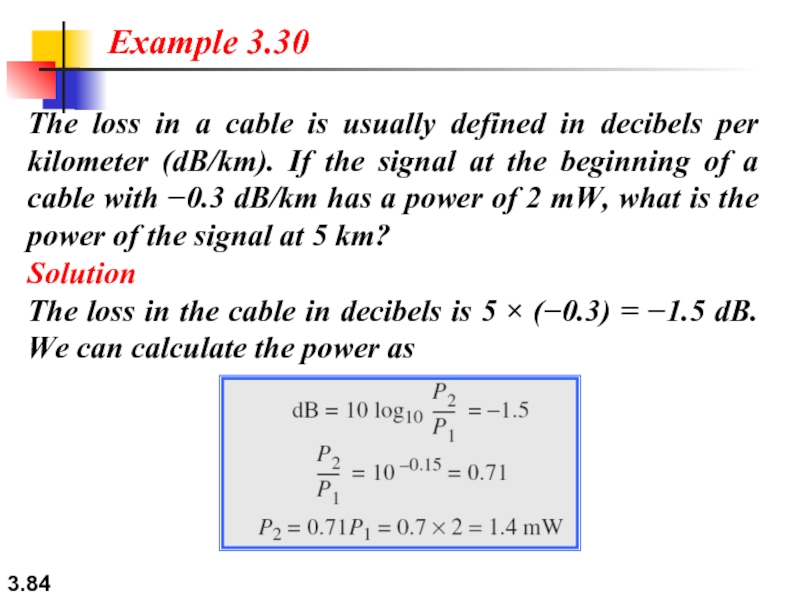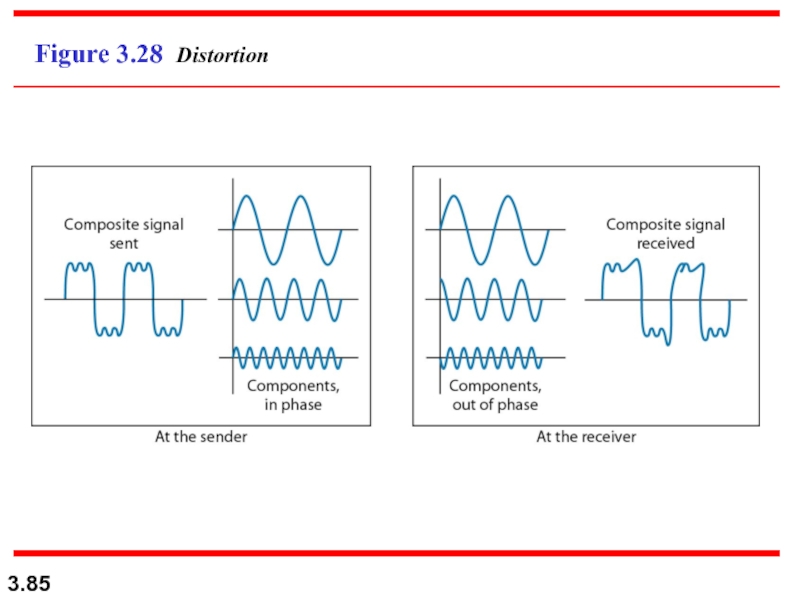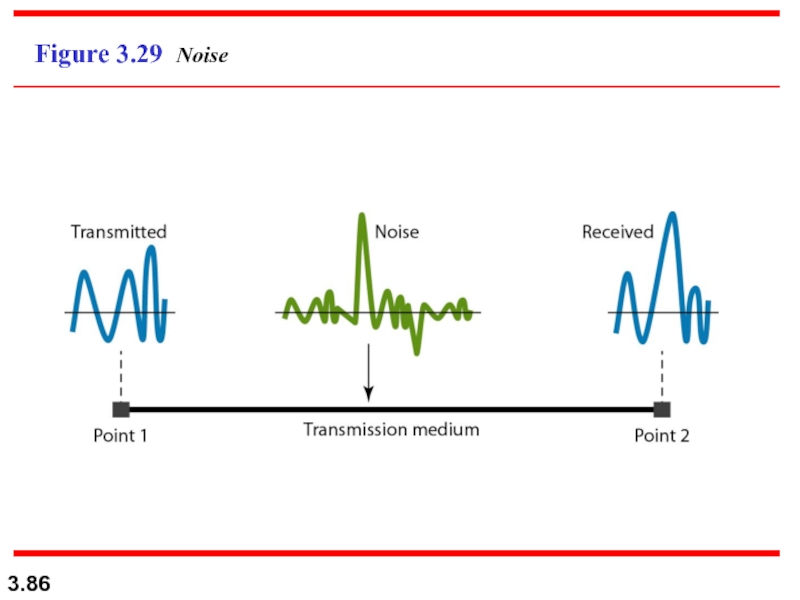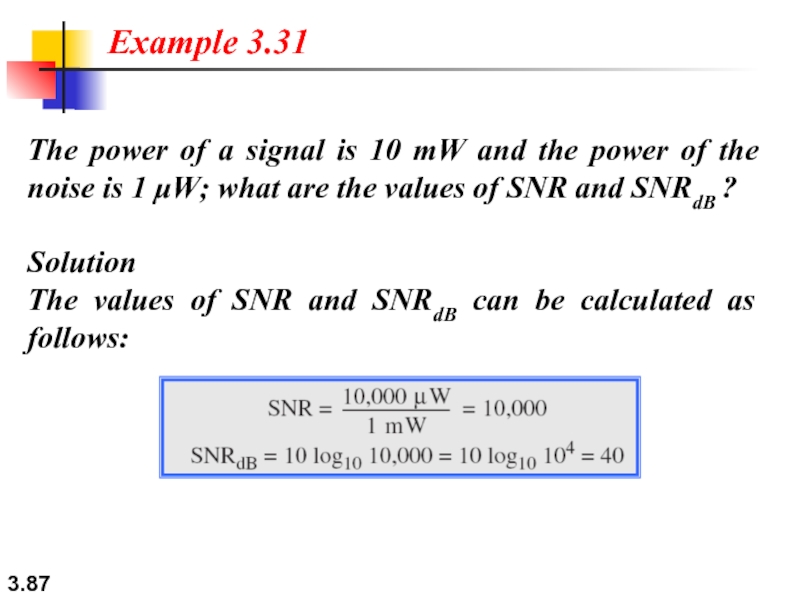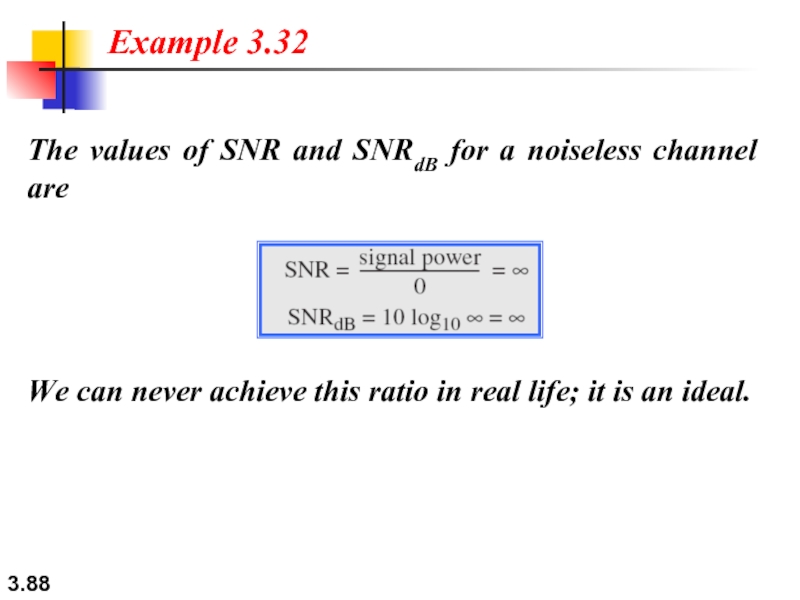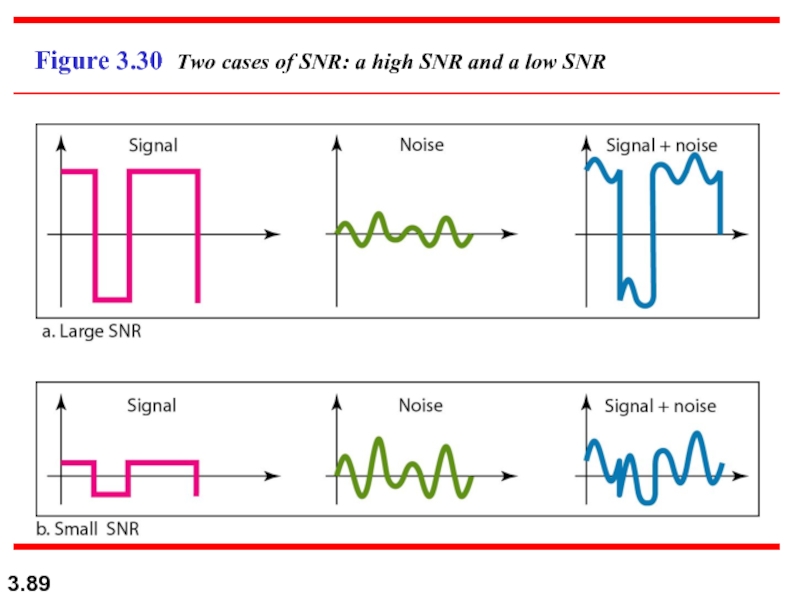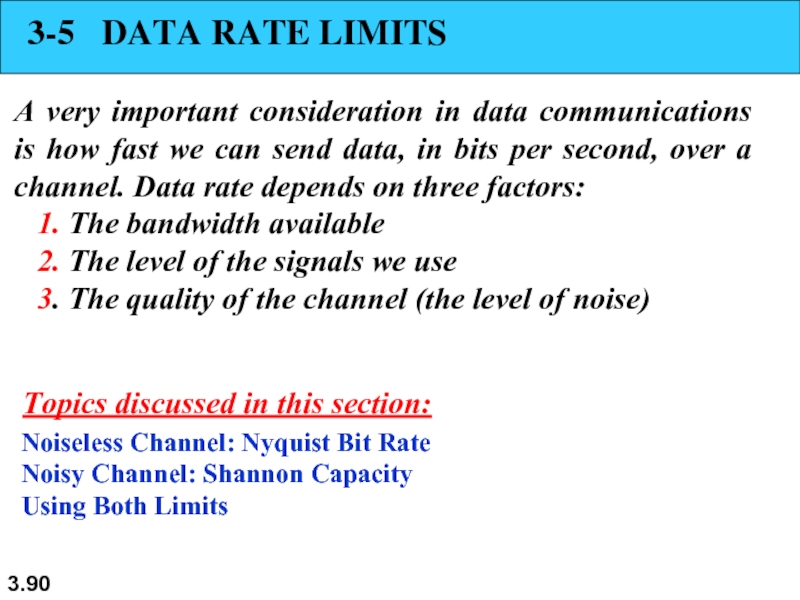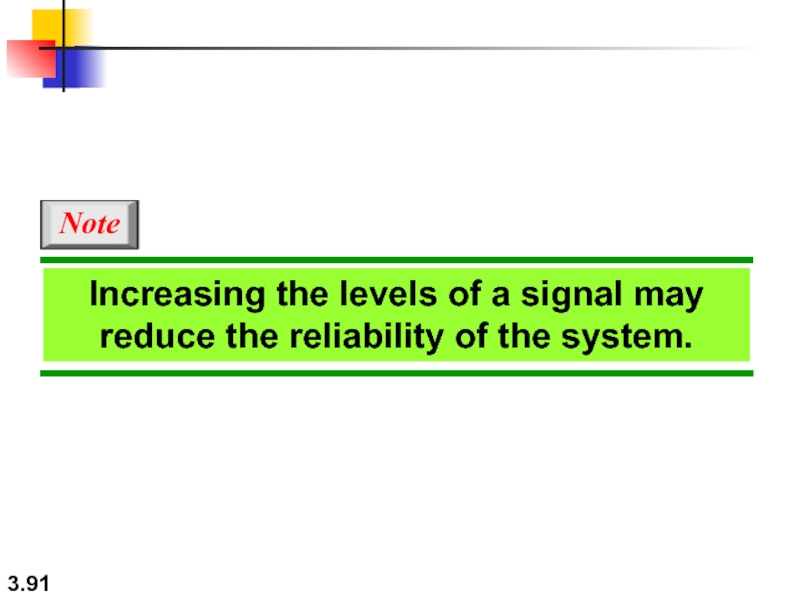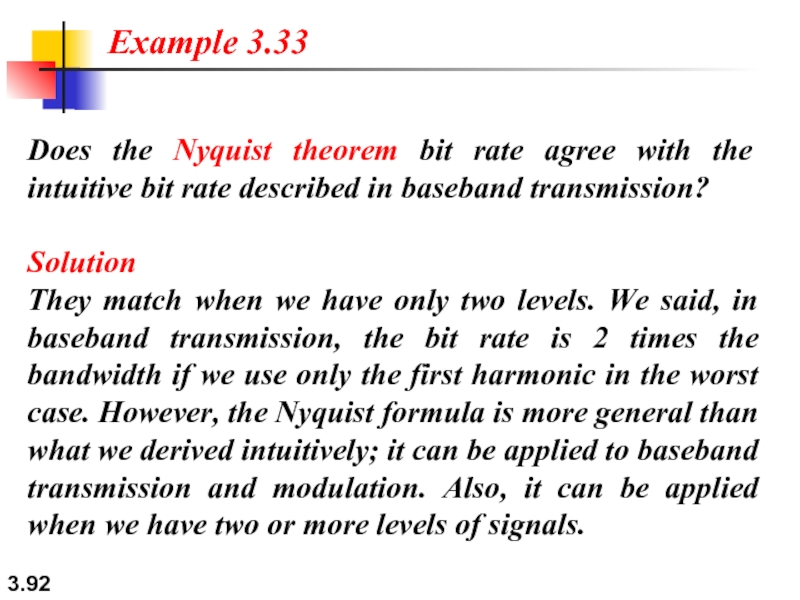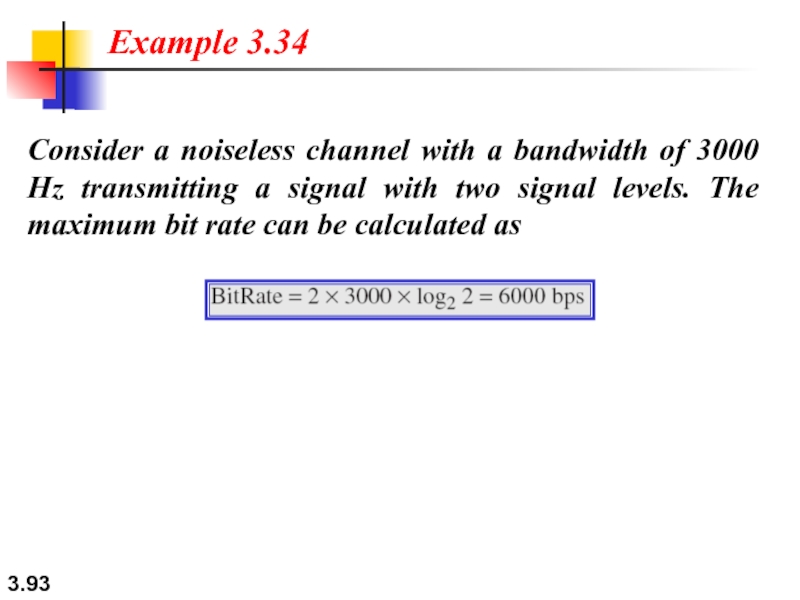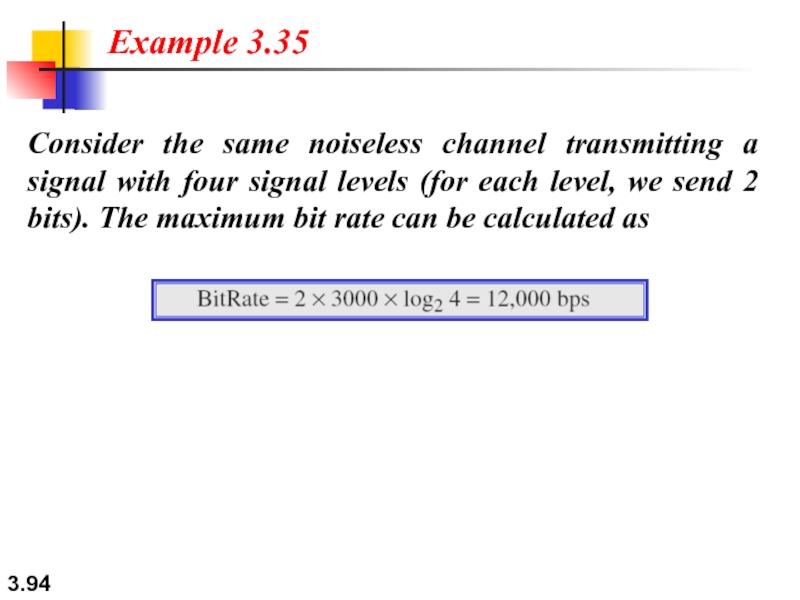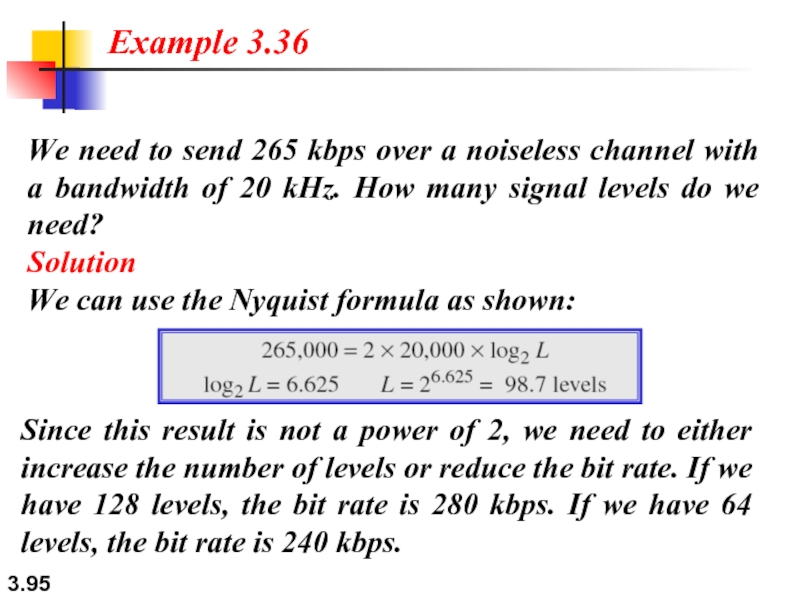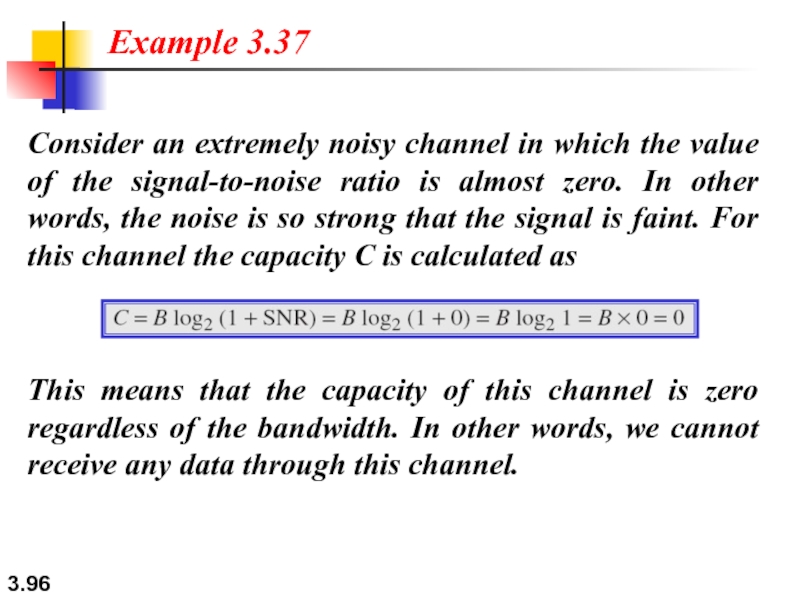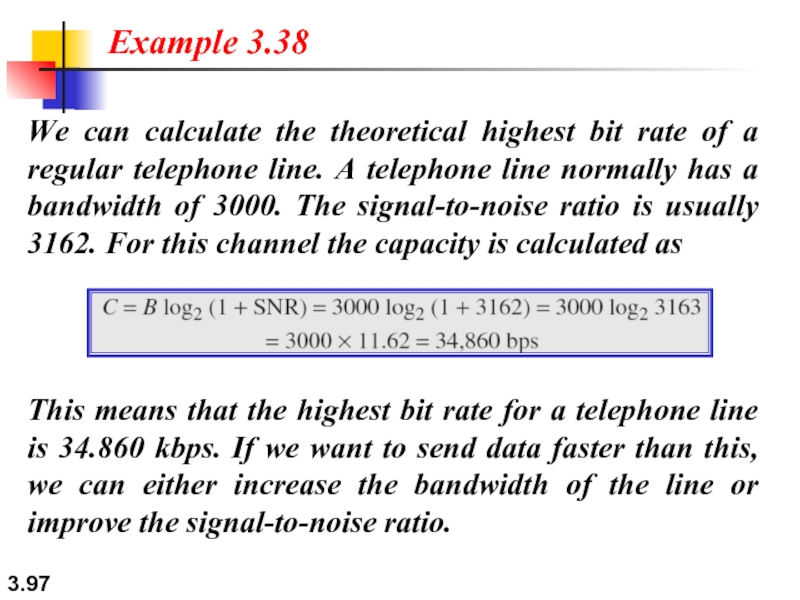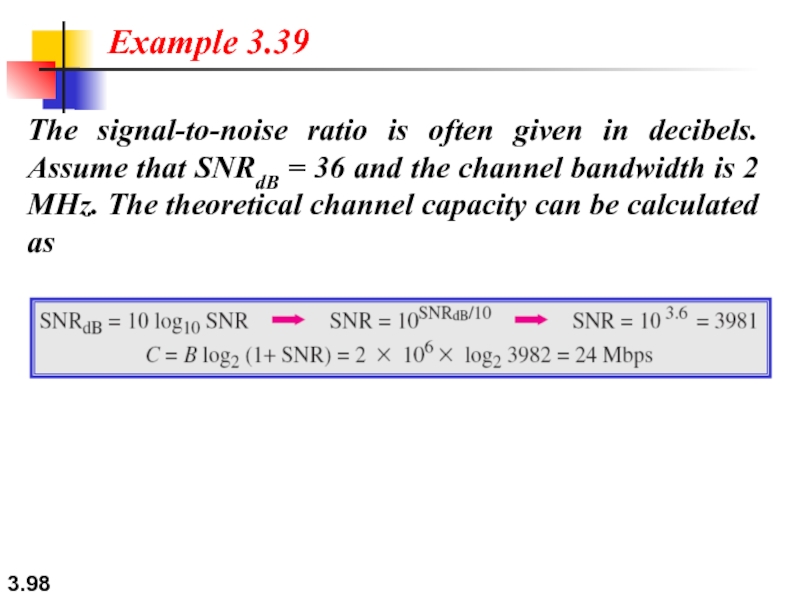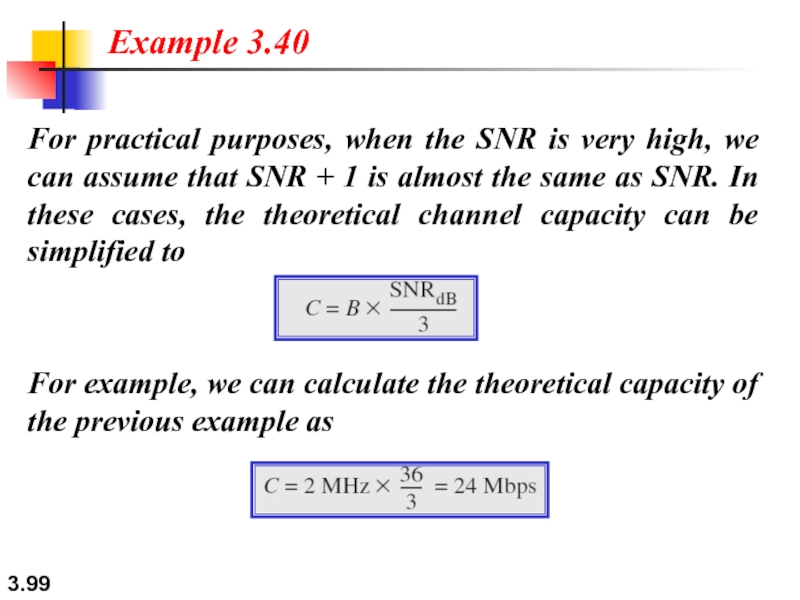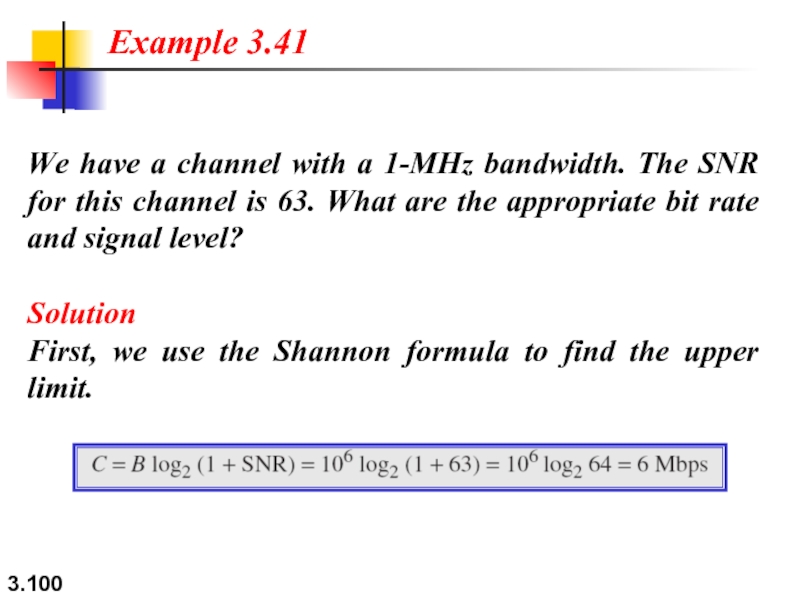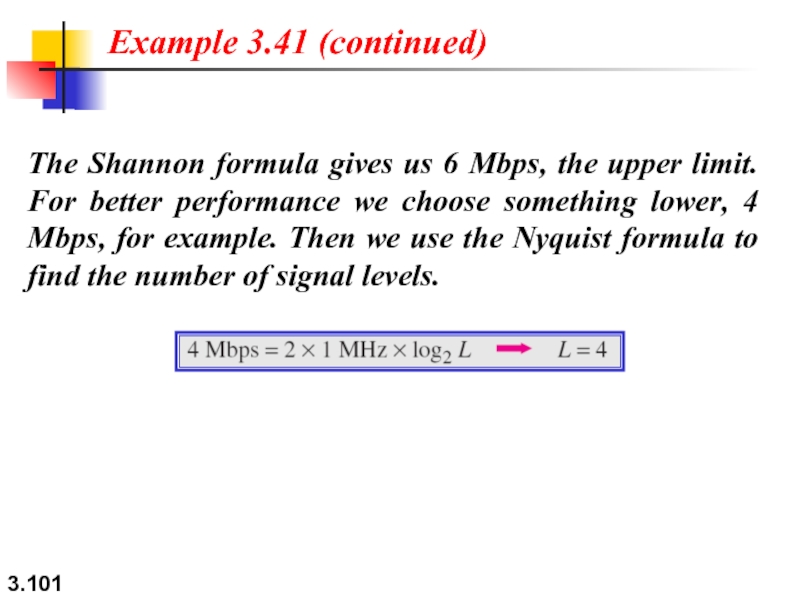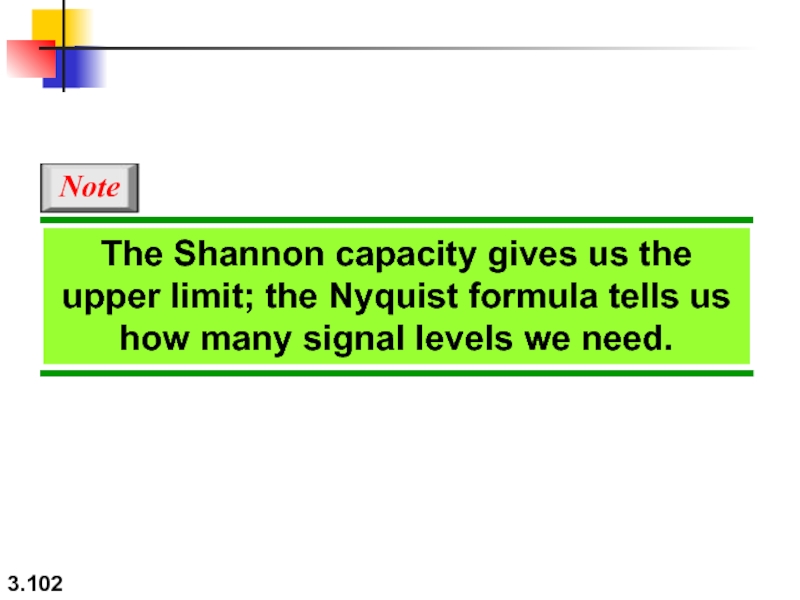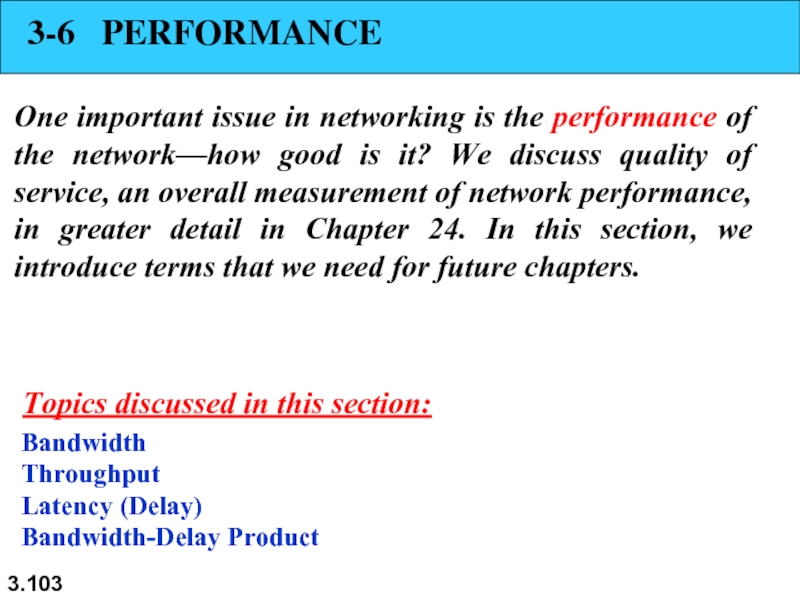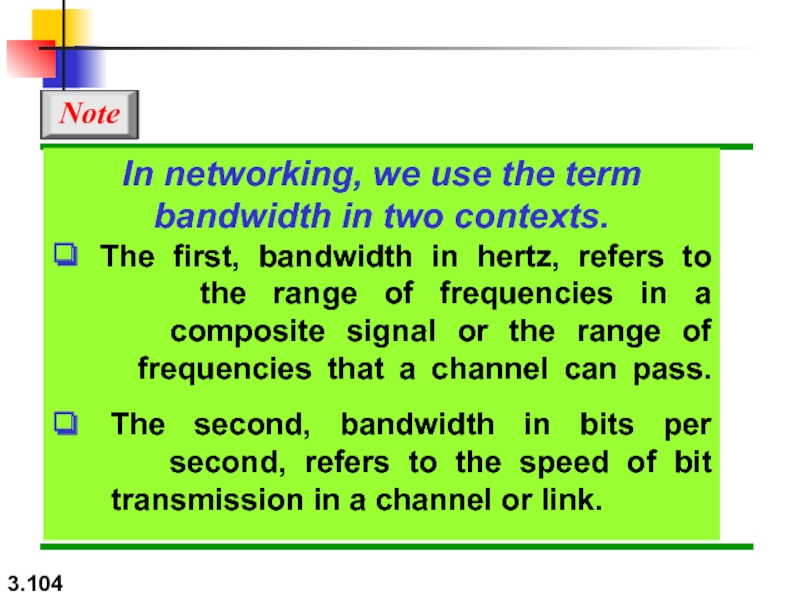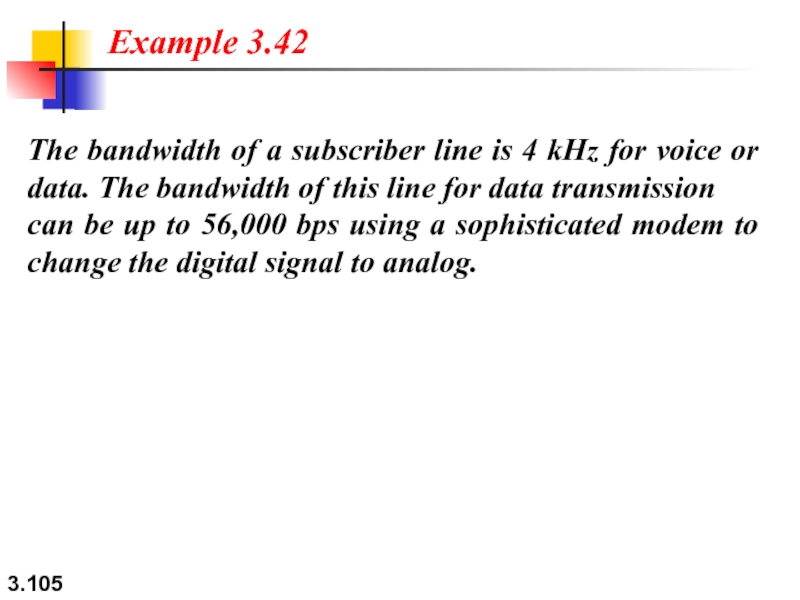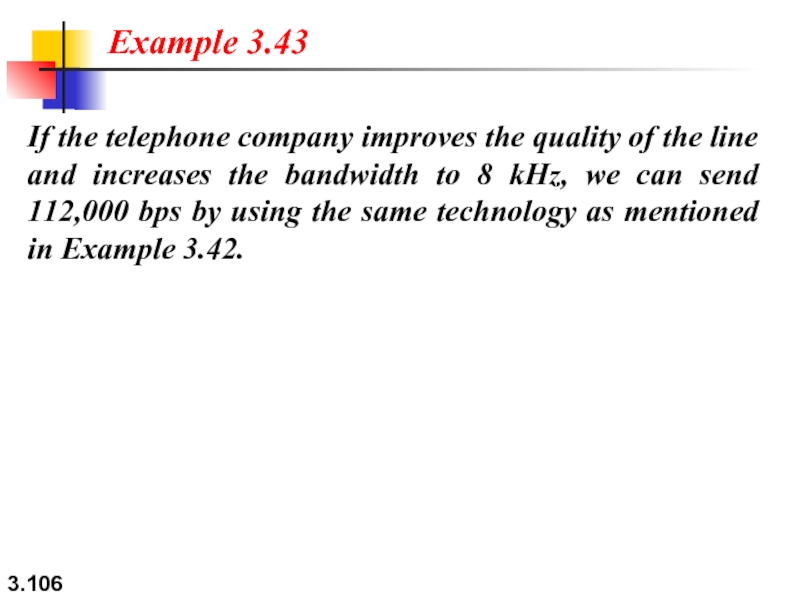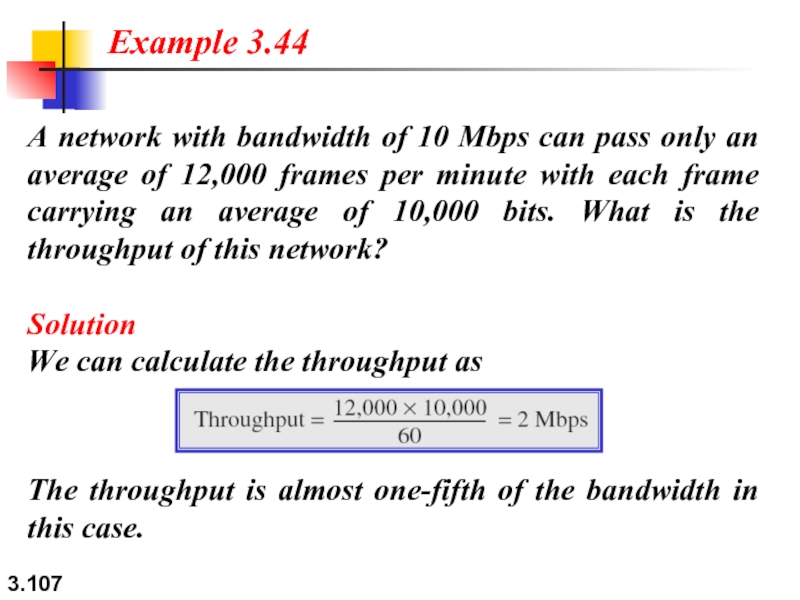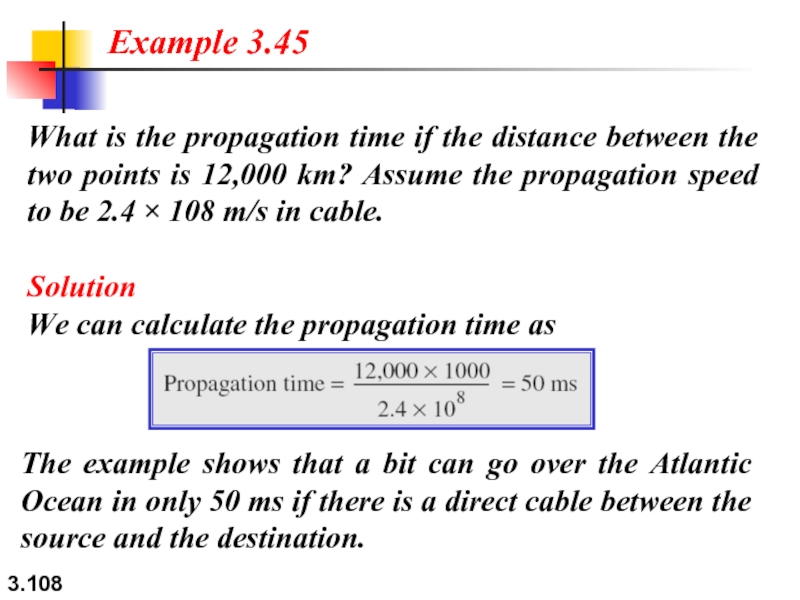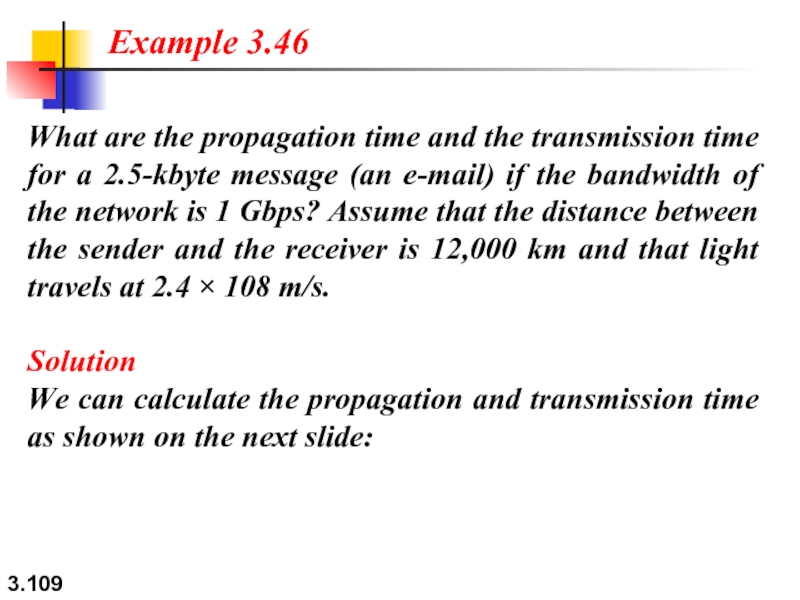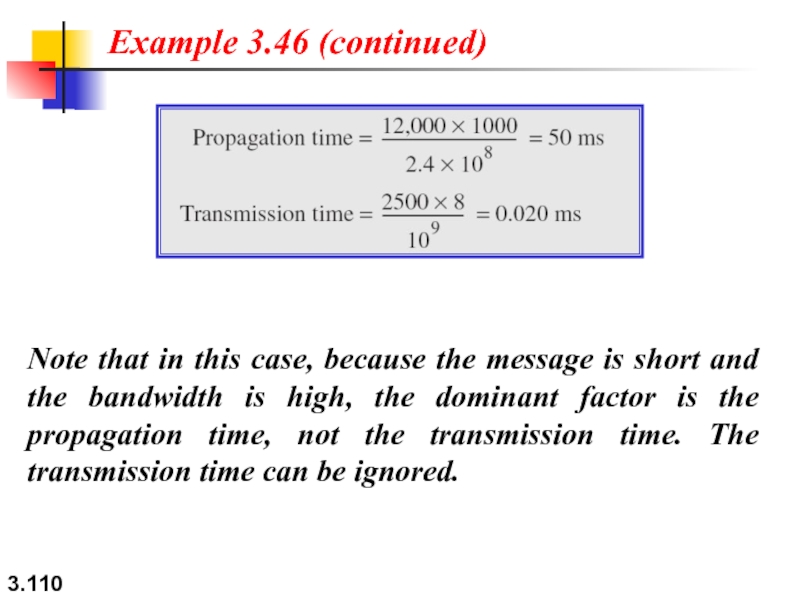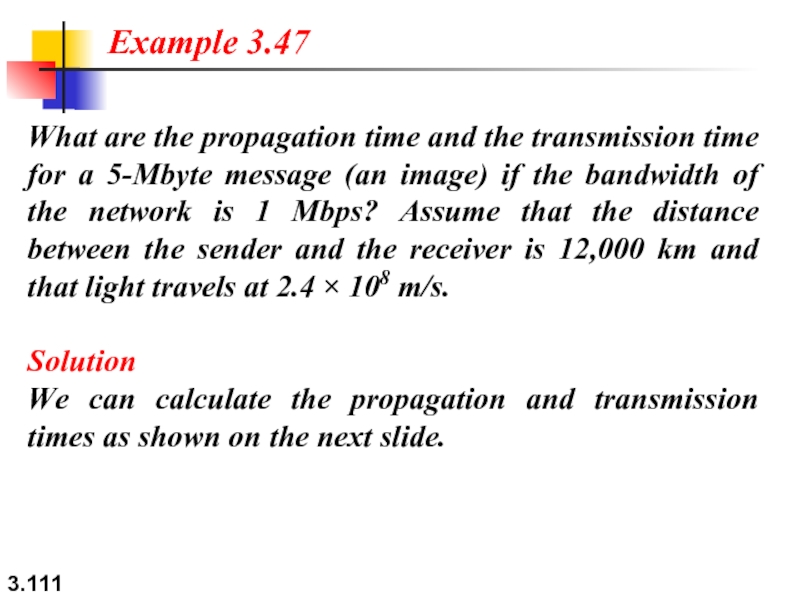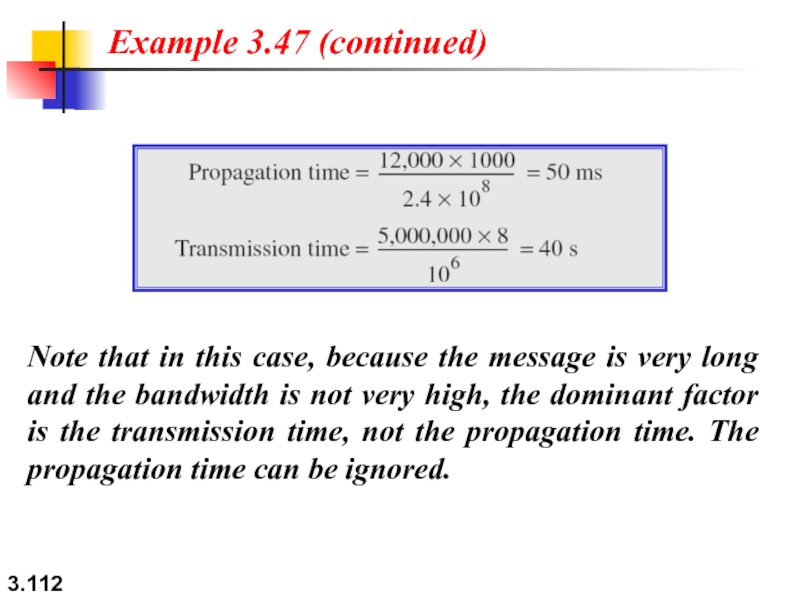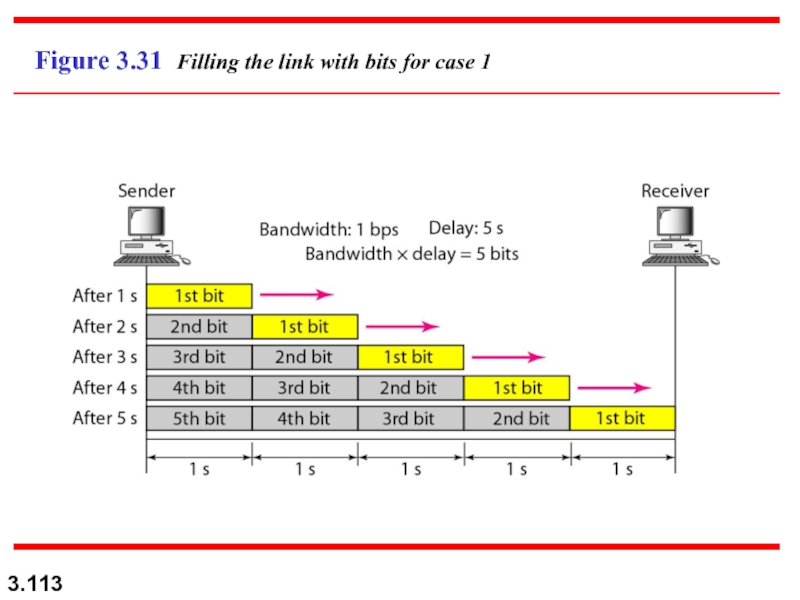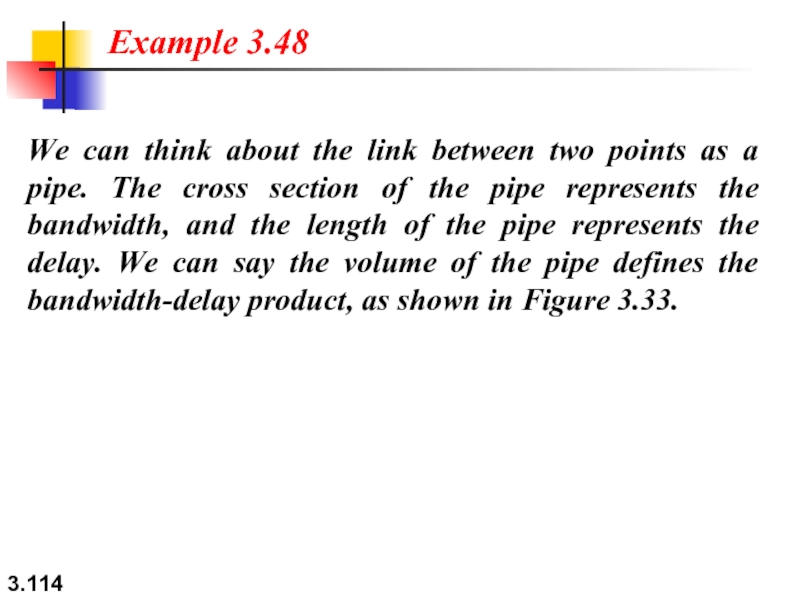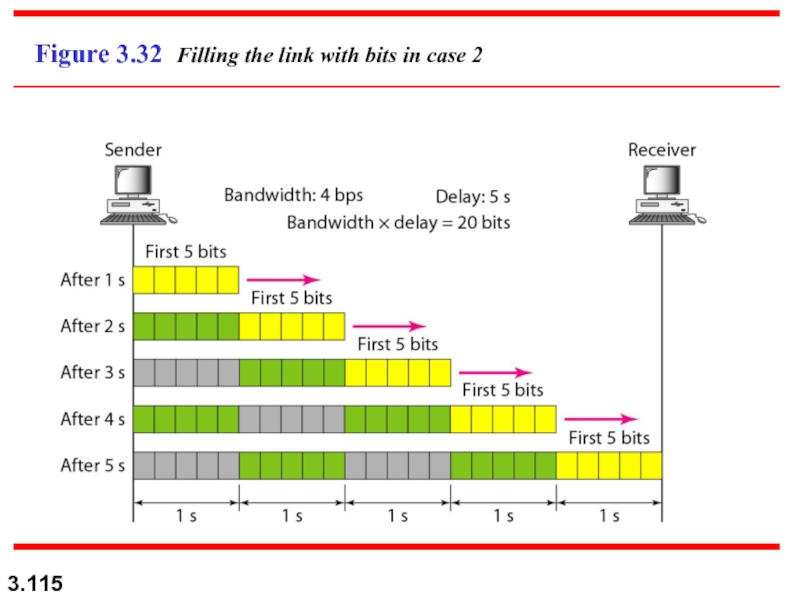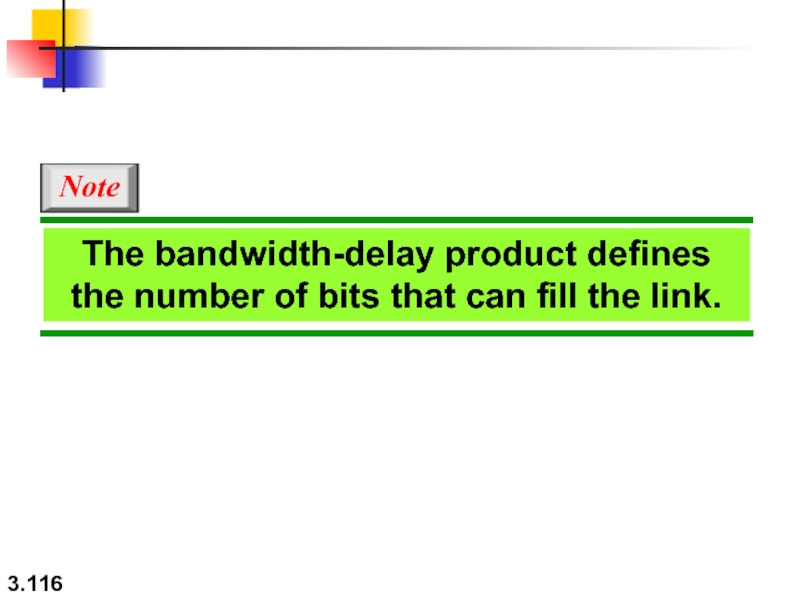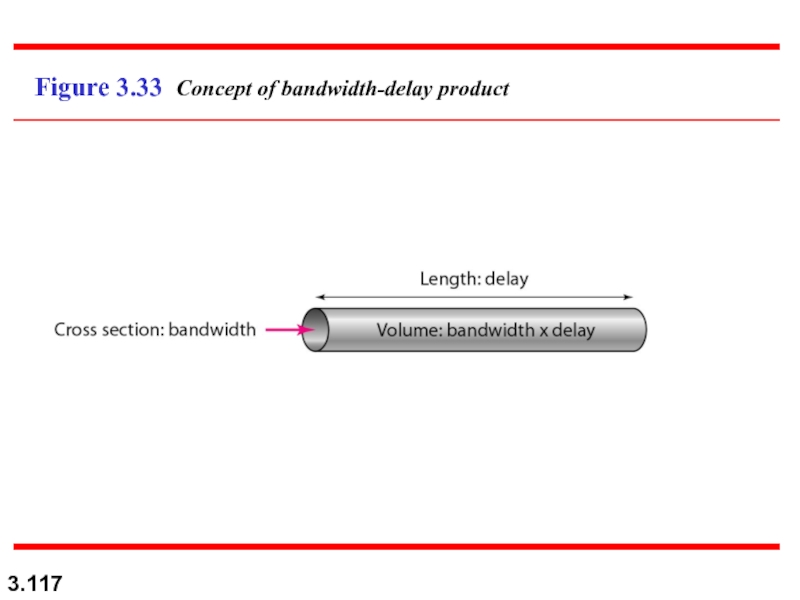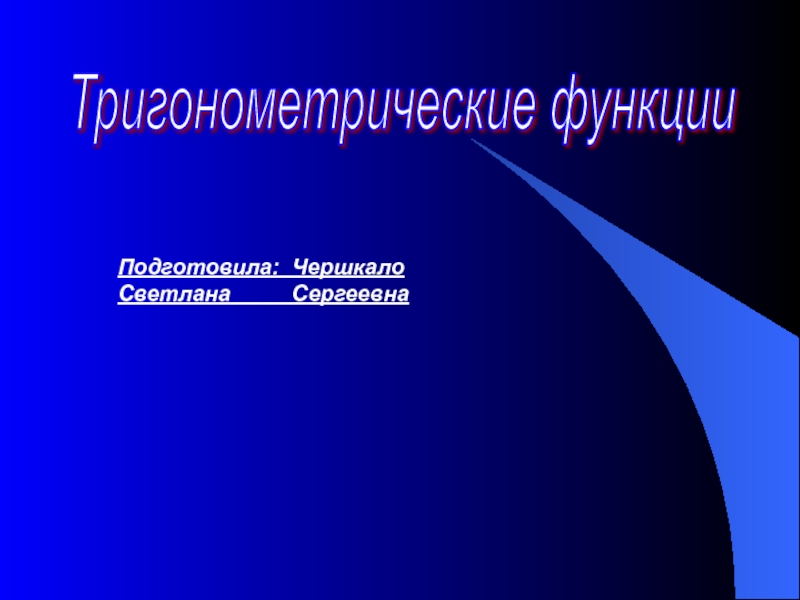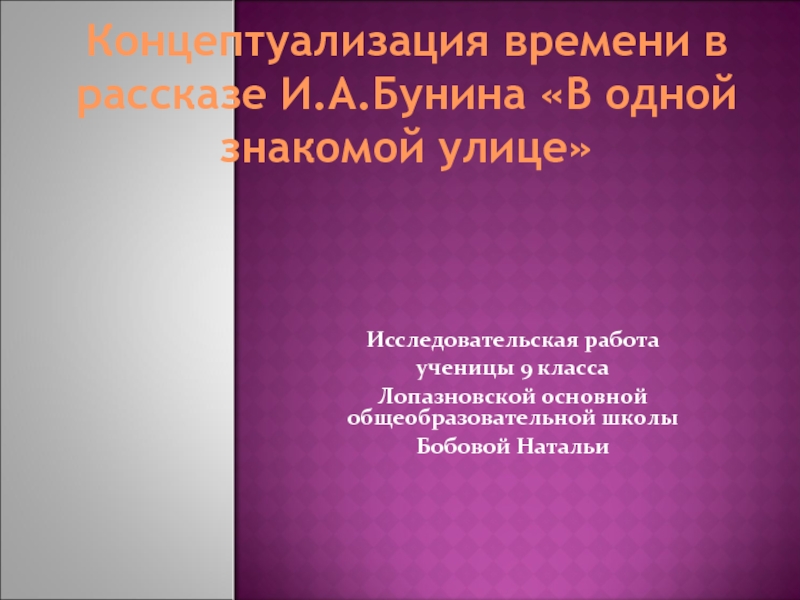- Главная
- Разное
- Дизайн
- Бизнес и предпринимательство
- Аналитика
- Образование
- Развлечения
- Красота и здоровье
- Финансы
- Государство
- Путешествия
- Спорт
- Недвижимость
- Армия
- Графика
- Культурология
- Еда и кулинария
- Лингвистика
- Английский язык
- Астрономия
- Алгебра
- Биология
- География
- Детские презентации
- Информатика
- История
- Литература
- Маркетинг
- Математика
- Медицина
- Менеджмент
- Музыка
- МХК
- Немецкий язык
- ОБЖ
- Обществознание
- Окружающий мир
- Педагогика
- Русский язык
- Технология
- Физика
- Философия
- Химия
- Шаблоны, картинки для презентаций
- Экология
- Экономика
- Юриспруденция
Chapter 3 Data and Signals презентация
Содержание
- 1. Chapter 3 Data and Signals
- 2. 3.
- 3. 3.
- 4. 3. 3-1 ANALOG AND DIGITAL
- 5. 3.
- 6. 3.
- 7. 3. Figure 3.1 Comparison of analog and digital signals
- 8. 3.
- 9. 3. 3-2 PERIODIC ANALOG SIGNALS
- 10. 3. Figure 3.2 A sine wave
- 11. 3.
- 12. 3.
- 13. 3. Figure 3.3 Two signals with the
- 14. 3.
- 15. 3.
- 16. 3. Figure 3.4 Two signals with the
- 17. 3. Table 3.1 Units of period and frequency
- 18. 3.
- 19. 3.
- 20. 3.
- 21. 3.
- 22. 3.
- 23. 3.
- 24. 3. Figure 3.5 Three sine waves with
- 25. 3.
- 26. 3. Figure 3.6 Wavelength and period
- 27. 3. Figure 3.7 The time-domain and frequency-domain plots of a sine wave
- 28. 3.
- 29. 3.
- 30. 3. Figure 3.8 The time domain and frequency domain of three sine waves
- 31. 3.
- 32. 3.
- 33. 3.
- 34. 3.
- 35. 3. Figure 3.9 A composite periodic signal
- 36. 3. Figure 3.10 Decomposition of a composite
- 37. 3.
- 38. 3. Figure 3.11 The time and frequency domains of a nonperiodic signal
- 39. 3.
- 40. 3. Figure 3.12 The bandwidth of periodic and nonperiodic composite signals
- 41. 3.
- 42. 3. Figure 3.13 The bandwidth for Example 3.10
- 43. 3.
- 44. 3. Figure 3.14 The bandwidth for Example 3.11
- 45. 3.
- 46. 3. Figure 3.15 The bandwidth for Example 3.12
- 47. 3.
- 48. 3.
- 49. 3.
- 50. 3. 3-3 DIGITAL SIGNALS
- 51. 3. Figure 3.16 Two digital signals: one
- 52. 3.
- 53. 3.
- 54. 3.
- 55. 3.
- 56. 3.
- 57. 3.
- 58. 3. Figure 3.17 The time and frequency
- 59. 3. Figure 3.18 Baseband transmission
- 60. 3.
- 61. 3. Figure 3.19 Bandwidths of two low-pass channels
- 62. 3. Figure 3.20 Baseband transmission using a dedicated medium
- 63. 3.
- 64. 3.
- 65. 3. Figure 3.21 Rough approximation of a
- 66. 3. Figure 3.22 Simulating a digital signal with first three harmonics
- 67. 3.
- 68. 3. Table 3.2 Bandwidth requirements
- 69. 3.
- 70. 3.
- 71. 3. Figure 3.23 Bandwidth of a bandpass channel
- 72. 3.
- 73. 3. Figure 3.24 Modulation of a digital
- 74. 3.
- 75. 3.
- 76. 3. 3-4 TRANSMISSION IMPAIRMENT
- 77. 3. Figure 3.25 Causes of impairment
- 78. 3. Figure 3.26 Attenuation LOSS of energy in overcoming the resistance of the medium
- 79. 3.
- 80. 3.
- 81. 3.
- 82. 3. Figure 3.27 Decibels for Example 3.28
- 83. 3.
- 84. 3.
- 85. 3. Figure 3.28 Distortion
- 86. 3. Figure 3.29 Noise
- 87. 3.
- 88. 3.
- 89. 3. Figure 3.30 Two cases of SNR: a high SNR and a low SNR
- 90. 3. 3-5 DATA RATE LIMITS
- 91. 3.
- 92. 3.
- 93. 3.
- 94. 3.
- 95. 3.
- 96. 3.
- 97. 3.
- 98. 3.
- 99. 3.
- 100. 3.
- 101. 3.
- 102. 3.
- 103. 3. 3-6 PERFORMANCE One
- 104. 3.
- 105. 3.
- 106. 3.
- 107. 3.
- 108. 3.
- 109. 3.
- 110. 3.
- 111. 3.
- 112. 3.
- 113. 3. Figure 3.31 Filling the link with bits for case 1
- 114. 3.
- 115. 3. Figure 3.32 Filling the link with bits in case 2
- 116. 3.
- 117. 3. Figure 3.33 Concept of bandwidth-delay product
Слайд 13.
Chapter 3
Data and Signals
Copyright © The McGraw-Hill Companies, Inc. Permission required
Слайд 43.
3-1 ANALOG AND DIGITAL
Data can be analog or digital. The
Analog and Digital Data
Analog and Digital Signals
Periodic and Nonperiodic Signals
Topics discussed in this section:
Слайд 53.
Data can be analog or digital.
Analog data are continuous and
Digital data have discrete states and take discrete values.
Слайд 63.
Signals can be analog or digital.
Analog signals can have an
Слайд 83.
In data communications, we commonly use periodic analog signals and nonperiodic
Слайд 93.
3-2 PERIODIC ANALOG SIGNALS
Periodic analog signals can be classified as
periodic analog signal is composed of multiple sine waves.
Sine Wave
Wavelength
Time and Frequency Domain
Composite Signals
Bandwidth
Topics discussed in this section:
Слайд 123.
The power in your house can be represented by a sine
Example 3.1
Слайд 143.
The voltage of a battery is a constant; this constant value
Example 3.2
Слайд 183.
The power we use at home has a frequency of 60
Example 3.3
Слайд 193.
Express a period of 100 ms in microseconds.
Example 3.4
Solution
From Table 3.1
Слайд 203.
The period of a signal is 100 ms. What is its
Example 3.5
Solution
First we change 100 ms to seconds, and then we calculate the frequency from the period (1 Hz = 10−3 kHz).
Слайд 213.
Frequency is the rate of change with respect to time.
Change
means high frequency. Change over a long span of time means low frequency.
Слайд 223.
If a signal does not change at all, its frequency is
If a signal changes instantaneously, its frequency is infinite.
Слайд 253.
A sine wave is offset 1/6 cycle with respect to time
Example 3.6
Solution
We know that 1 complete cycle is 360°. Therefore, 1/6 cycle is
Слайд 283.
A complete sine wave in the time domain can be represented
Слайд 293.
The frequency domain is more compact and useful when we are
Example 3.7
Слайд 313.
A single-frequency sine wave is not useful in data communications;
we need
Слайд 323.
According to Fourier analysis, any composite signal is a combination of
simple
Fourier analysis is discussed in Appendix C.
Слайд 333.
If the composite signal is periodic, the decomposition gives a series
Слайд 343.
Figure 3.9 shows a periodic composite signal with frequency f. This
Example 3.8
Слайд 363.
Figure 3.10 Decomposition of a composite periodic signal in the time
Слайд 373.
Figure 3.11 shows a nonperiodic composite signal. It can be the
Example 3.9
Слайд 393.
The bandwidth of a composite signal is the difference between the
highest
Слайд 413.
If a periodic signal is decomposed into five sine waves with
Solution
Let fh be the highest frequency, fl the lowest frequency, and B the bandwidth. Then
Example 3.10
The spectrum has only five spikes, at 100, 300, 500, 700, and 900 Hz (see Figure 3.13).
Слайд 433.
A periodic signal has a bandwidth of 20 Hz. The highest
Solution
Let fh be the highest frequency, fl the lowest frequency, and B the bandwidth. Then
Example 3.11
The spectrum contains all integer frequencies. We show this by a series of spikes (see Figure 3.14).
Слайд 453.
A nonperiodic composite signal has a bandwidth of 200 kHz, with
Solution
The lowest frequency must be at 40 kHz and the highest at 240 kHz. Figure 3.15 shows the frequency domain and the bandwidth.
Example 3.12
Слайд 473.
An example of a nonperiodic composite signal is the signal propagated
Example 3.13
Слайд 483.
Another example of a nonperiodic composite signal is the signal propagated
Example 3.14
Слайд 493.
Another example of a nonperiodic composite signal is the signal received
Example 3.15
Слайд 503.
3-3 DIGITAL SIGNALS
In addition to being represented by an analog
Bit Rate
Bit Length
Digital Signal as a Composite Analog Signal
Application Layer
Topics discussed in this section:
Слайд 513.
Figure 3.16 Two digital signals: one with two signal levels and
Слайд 523.
Appendix C reviews information about exponential and logarithmic functions.
Appendix C reviews
Слайд 533.
A digital signal has eight levels. How many bits are needed
Example 3.16
Each signal level is represented by 3 bits.
Слайд 543.
A digital signal has nine levels. How many bits are needed
Example 3.17
Слайд 553.
Assume we need to download text documents at the rate of
Solution
A page is an average of 24 lines with 80 characters in each line. If we assume that one character requires 8 bits, the bit rate is
Example 3.18
Слайд 563.
A digitized voice channel, as we will see in Chapter 4,
Solution
The bit rate can be calculated as
Example 3.19
Слайд 573.
What is the bit rate for high-definition TV (HDTV)?
Solution
HDTV uses digital
Example 3.20
The TV stations reduce this rate to 20 to 40 Mbps through compression.
Слайд 633.
Baseband transmission of a digital signal that preserves the shape of
Слайд 643.
An example of a dedicated channel where the entire bandwidth of
Example 3.21
Слайд 653.
Figure 3.21 Rough approximation of a digital signal using the first
Слайд 673.
In baseband transmission, the required bandwidth is proportional to the bit
if we need to send bits faster, we need more bandwidth.
In baseband transmission, the required bandwidth is proportional to the bit rate;
if we need to send bits faster, we need more bandwidth.
Слайд 693.
What is the required bandwidth of a low-pass channel if we
Solution
The answer depends on the accuracy desired.
a. The minimum bandwidth, is B = bit rate /2, or 500 kHz.
b. A better solution is to use the first and the third harmonics with B = 3 × 500 kHz = 1.5 MHz.
c. Still a better solution is to use the first, third, and fifth harmonics with B = 5 × 500 kHz = 2.5 MHz.
Example 3.22
Слайд 703.
We have a low-pass channel with bandwidth 100 kHz. What is
channel?
Solution
The maximum bit rate can be achieved if we use the first harmonic. The bit rate is 2 times the available bandwidth, or 200 kbps.
Example 3.22
Слайд 723.
If the available channel is a bandpass channel, we cannot send
Слайд 743.
An example of broadband transmission using modulation is the sending of
Example 3.24
Слайд 753.
A second example is the digital cellular telephone. For better reception,
Example 3.25
Слайд 763.
3-4 TRANSMISSION IMPAIRMENT
Signals travel through transmission media, which are not
Attenuation
Distortion
Noise
Topics discussed in this section:
Слайд 793.
Suppose a signal travels through a transmission medium and its power
Example 3.26
A loss of 3 dB (–3 dB) is equivalent to losing one-half the power.
Слайд 803.
A signal travels through an amplifier, and its power is increased
Example 3.27
Слайд 813.
One reason that engineers use the decibel to measure the changes
Example 3.28
Слайд 833.
Sometimes the decibel is used to measure signal power in milliwatts.
Solution
We can calculate the power in the signal as
Example 3.29
Слайд 843.
The loss in a cable is usually defined in decibels per
Solution
The loss in the cable in decibels is 5 × (−0.3) = −1.5 dB. We can calculate the power as
Example 3.30
Слайд 873.
The power of a signal is 10 mW and the power
Solution
The values of SNR and SNRdB can be calculated as follows:
Example 3.31
Слайд 883.
The values of SNR and SNRdB for a noiseless channel are
Example
We can never achieve this ratio in real life; it is an ideal.
Слайд 903.
3-5 DATA RATE LIMITS
A very important consideration in data communications
1. The bandwidth available
2. The level of the signals we use
3. The quality of the channel (the level of noise)
Noiseless Channel: Nyquist Bit Rate
Noisy Channel: Shannon Capacity
Using Both Limits
Topics discussed in this section:
Слайд 923.
Does the Nyquist theorem bit rate agree with the intuitive bit
Solution
They match when we have only two levels. We said, in baseband transmission, the bit rate is 2 times the bandwidth if we use only the first harmonic in the worst case. However, the Nyquist formula is more general than what we derived intuitively; it can be applied to baseband transmission and modulation. Also, it can be applied when we have two or more levels of signals.
Example 3.33
Слайд 933.
Consider a noiseless channel with a bandwidth of 3000 Hz transmitting
Example 3.34
Слайд 943.
Consider the same noiseless channel transmitting a signal with four signal
Example 3.35
Слайд 953.
We need to send 265 kbps over a noiseless channel with
Solution
We can use the Nyquist formula as shown:
Example 3.36
Since this result is not a power of 2, we need to either increase the number of levels or reduce the bit rate. If we have 128 levels, the bit rate is 280 kbps. If we have 64 levels, the bit rate is 240 kbps.
Слайд 963.
Consider an extremely noisy channel in which the value of the
Example 3.37
This means that the capacity of this channel is zero regardless of the bandwidth. In other words, we cannot receive any data through this channel.
Слайд 973.
We can calculate the theoretical highest bit rate of a regular
Example 3.38
This means that the highest bit rate for a telephone line is 34.860 kbps. If we want to send data faster than this, we can either increase the bandwidth of the line or improve the signal-to-noise ratio.
Слайд 983.
The signal-to-noise ratio is often given in decibels. Assume that SNRdB
Example 3.39
Слайд 993.
For practical purposes, when the SNR is very high, we can
Example 3.40
For example, we can calculate the theoretical capacity of the previous example as
Слайд 1003.
We have a channel with a 1-MHz bandwidth. The SNR for
Solution
First, we use the Shannon formula to find the upper limit.
Example 3.41
Слайд 1013.
The Shannon formula gives us 6 Mbps, the upper limit. For
Example 3.41 (continued)
Слайд 1023.
The Shannon capacity gives us the upper limit; the Nyquist formula
Слайд 1033.
3-6 PERFORMANCE
One important issue in networking is the performance of
Bandwidth
Throughput
Latency (Delay)
Bandwidth-Delay Product
Topics discussed in this section:
Слайд 1043.
In networking, we use the term bandwidth in two contexts.
❏ The
❏ The second, bandwidth in bits per second, refers to the speed of bit transmission in a channel or link.
Слайд 1053.
The bandwidth of a subscriber line is 4 kHz for voice
can be up to 56,000 bps using a sophisticated modem to change the digital signal to analog.
Example 3.42
Слайд 1063.
If the telephone company improves the quality of the line and
Example 3.43
Слайд 1073.
A network with bandwidth of 10 Mbps can pass only an
Solution
We can calculate the throughput as
Example 3.44
The throughput is almost one-fifth of the bandwidth in this case.
Слайд 1083.
What is the propagation time if the distance between the two
Solution
We can calculate the propagation time as
Example 3.45
The example shows that a bit can go over the Atlantic Ocean in only 50 ms if there is a direct cable between the source and the destination.
Слайд 1093.
What are the propagation time and the transmission time for a
Solution
We can calculate the propagation and transmission time as shown on the next slide:
Example 3.46
Слайд 1103.
Note that in this case, because the message is short and
Example 3.46 (continued)
Слайд 1113.
What are the propagation time and the transmission time for a
Solution
We can calculate the propagation and transmission times as shown on the next slide.
Example 3.47
Слайд 1123.
Note that in this case, because the message is very long
Example 3.47 (continued)
Слайд 1143.
We can think about the link between two points as a
Example 3.48
